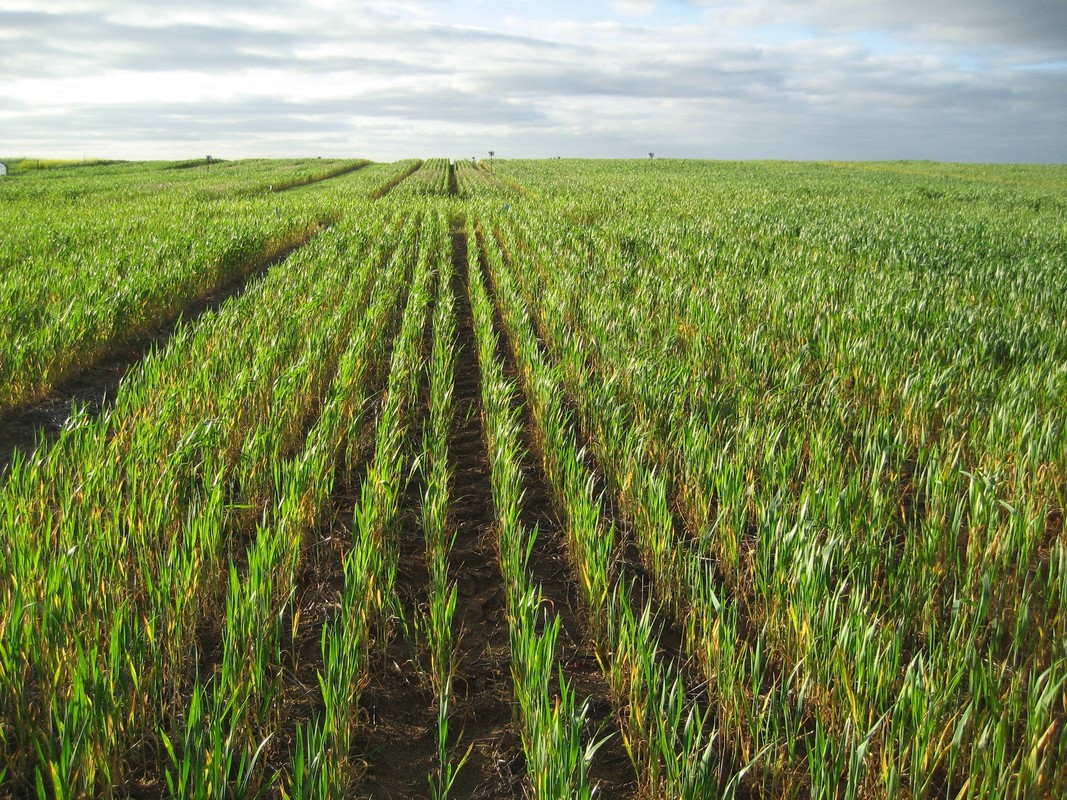Iain Wilson: a personal impact culture story
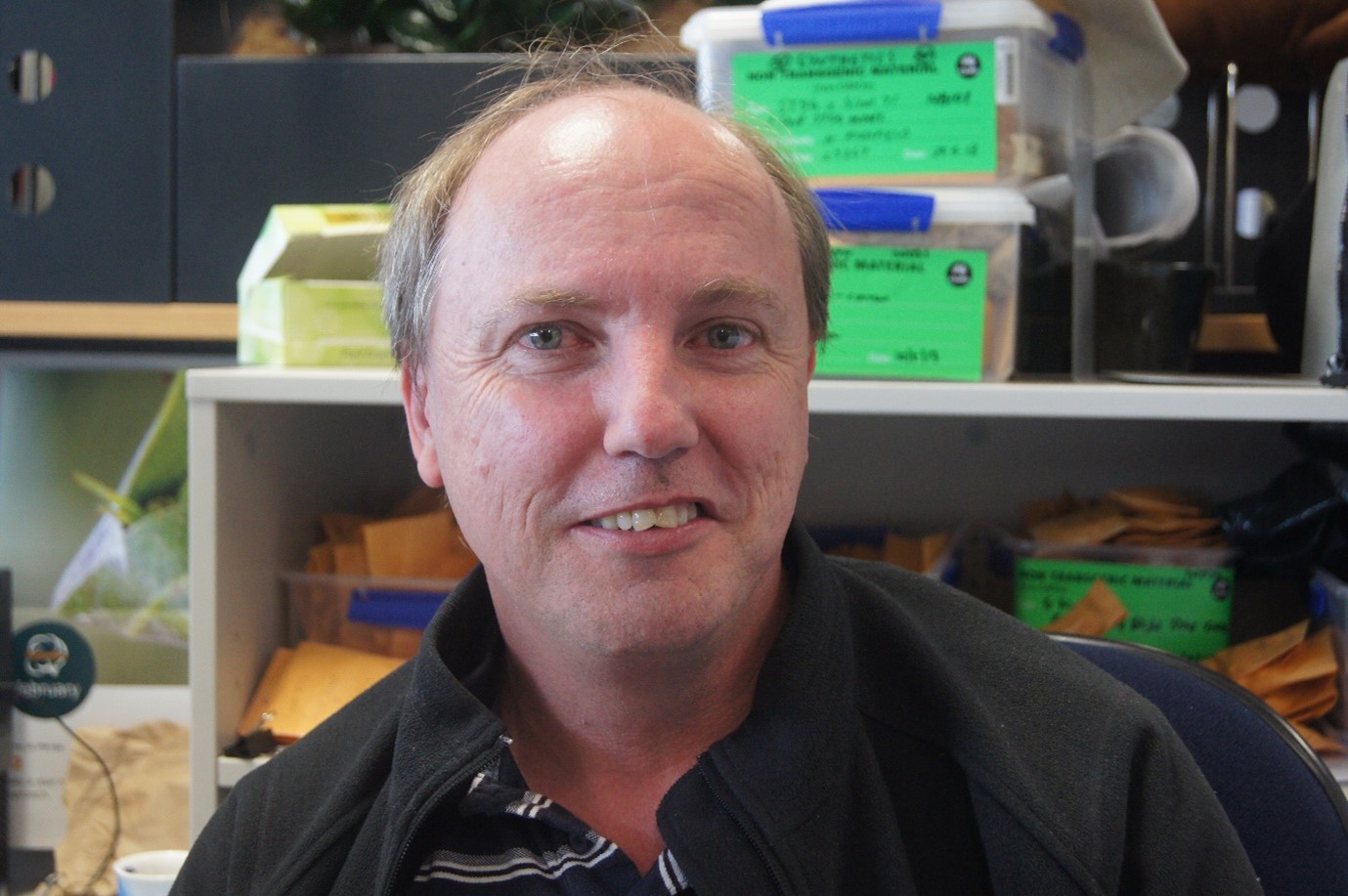 This month in our series ‘In Their Own Words: Researcher Stories’, we spoke with Dr Iain Wilson, Principal Research Scientist in the Molecular Breeding Team. Iain was recently recognised for his 25 years of service with CSIRO and he reflected on his journey thus far.
This month in our series ‘In Their Own Words: Researcher Stories’, we spoke with Dr Iain Wilson, Principal Research Scientist in the Molecular Breeding Team. Iain was recently recognised for his 25 years of service with CSIRO and he reflected on his journey thus far.
How did you begin your career with CSIRO?
I was recruited by Liz Dennis and Jim Peacock to what was then CSIRO Plant Industry, from the Carnegie Institution of Washington (Stanford) at the end of 1999. Microarrays, a cutting-edge technology at the time to analyse large-scale gene expression patterns, were developed at Stanford in Pat Brown’s laboratory, and I was one of the first to apply microarrays to plant research using Arabidopsis as a model system.
At CSIRO, I set up one of the first functioning microarray facilities in Australia. The focus at the time was on fundamental research mostly in model species such as Arabidopsis, with the goal of expanding knowledge on a wide variety of areas, with the impact mostly measured by the publication quality and number. The then large-scale nature of the data generated ‘new’ problems associated with the analysis and storing data. I identified this challenge and was involved in the hiring of Plant Industry’s first bioinformatician Gavin Kennedy (later replaced by Jen Taylor) and the development of partnerships with CSIRO Mathematical and Information Sciences that led to more rigorous ways of analysing complex datasets.
The development of these collaborations was significant as in the dim dark ages partnerships between CSIRO Divisions were difficult due to funding disincentives. It was only through the good will of very clever and inquisitive scientists in that division that made it work.
You have had a strong emphasis on impact throughout your career. When did you realise that science needs to embed impact?
In 2002, with sponsorship by Graingene (an alliance between CSIRO and Syngenta) the microarray work shifted from Arabidopsis to producing a large-scale array for wheat. This array, containing over 36,000 clones over three separate slides, was applied to characterise alternative wheat dwarfing genes and carbohydrate mobilisation in wheat. However, due to its use being restricted to only Graingene projects, this work failed to make a major impact in wheat research in Plant Industry.
In 2005, my work shifted to cotton with funding from Cottech - an alliance between CSIRO, Cotton Seed Distributors (CSD) and the Cotton Research and Development Corporation (CRDC). The aim was to study waterlogging tolerance, first in Arabidopsis, and then applying the findings to cotton via a transgenic approach by overexpressing key anaerobic response genes.
This work really epitomised the period where it was thought that there were simple genetic modification solutions to complex problems, largely based on the success of Bt cotton in combating the insect problem that almost ended the cotton industry in Australia.
In hindsight this period of work was more about continuing previously successful research from model systems into a crop - its foundation wasn’t necessarily based in solving the problems that were considered important in the cotton industry. However, it’s also fair to say that the impact of the work also wasn’t helped by the upcoming millennial drought.
How did your relationship with the cotton breeding program begin?
In 2008 it was made abundantly clear to me by Frank Gubler and Danny Lewellyn that that era of model system research was ending, and the time for choosing a real crop was nigh. As I had experience with cotton, I was given the opportunity to lead a small group who worked on cotton disease resistance.
Before my arrival, the work was mostly focused on repeating the type of research carried out in model systems. However, I knew from previous work in Arabidopsis that cotton was not, and never would be, a model system and the only value of this research was in aiding the CSIRO cotton breeders to deliver more resistant varieties.
The breeders were initially distrustful of my interest as ‘molly bollies’ such as myself had promised so much but delivered so very little impact. The relationship took many years to develop, and it took many small wins and a focus on practical solutions rather than just publications.
You and your team have been long-term quiet achievers in the Australian cotton industry and often work in the background out of the spotlight. However, your research has had a huge impact on the industry. Tell us a bit more about what you have achieved.
Amongst various other outcomes, our work has been most widely recognised in the biotic resistance area. This has been observed in cotton varieties released with significantly improved Fusarium and Verticillium wilt resistances. In addition, the most recent varieties released and all future varieties in the development pipeline, contain resistance to the virus resulting in the disease Cotton Bunchy Top. My work has been pivotal in the identification of accurate molecular markers for Black Root Rot (BRR) resistance, enabling the development of germplasm with excellent resistance to BRR. The future impact of this work (variety release is expected in 6-8 years), particularly the Southern and cooler growing regions, will be significant. Recently the gene for Spider mite resistance was identified by Dr Qian-Hao Zhu, that turns out to be a susceptibility gene that when knocked out increase’s resistance. This provides an opportunity both to breed for resistance and or create resistant germplasm through mutation and gene editing. My research and research team has and continues to significantly improve the overall sustainability of the cotton industry, particularly from a disease management standpoint. My research achievements have greatly benefitted from the long-term funding relationship with Cotton Seed Distributors Ltd., who understand the long timelines involved.
I have come to appreciate the great work of breeders, the true phenomics profession, that is now embracing a panomics approach in order to accelerate genetic gain. I believe the partnership between my molecular group and the breeders really flourished when our goals were aligned: to release commercial varieties with improved resistance, but with elite yield and fibre quality.
In 2022, you were awarded the Australian Cotton Industry’s Research of the Year Award. Congratulations!
The award was a great honour, as it is an industry award that is rarely awarded to those working in the ‘ivory towers’ of Canberra. Although the work is not finished, the award indicates that my team is on the right path to delivering impact to the Australian cotton industry.
Finally, how would you sum up your key learnings?
Through the sometimes not so subtle teaching of Warwick Stiller and others, I have come to appreciate that disease resistance, although complex in itself, is just one trait among many. It is important but does not stand alone as it’s the complete package that is important. A simple but important point for all to realise is that your research fits into a larger world and must be compatible with it to have impact.
Thanks Iain and we look forward to seeing your future progress and success.
Iain Wilson’s career is a shining example of how CSIRO’s role in the innovation system is to create impact for our customers and more broadly Australia. It also highlights how a personal impact mindset journey can lead to both success in science and industry impact.
Soft launch of Bollgard 3 XtendFlex (B3XF) Cotton varieties at Australian Cotton Conference 2024
 The 2024 Australian Cotton Conference, held on Gold Coast between 6-8 August, was the largest gathering of cotton researchers and scientists, farmers and agronomists, marketers, industry organisations, spinners, brands and retailers in the event history.
The 2024 Australian Cotton Conference, held on Gold Coast between 6-8 August, was the largest gathering of cotton researchers and scientists, farmers and agronomists, marketers, industry organisations, spinners, brands and retailers in the event history.
One highlight was the soft launch of the Bollgard 3 XtendFlex (B3XF) Cotton varieties. These were bred by the CSIRO cotton breeding program and developed in collaboration with Cotton Seed Distributors and Bayer Crop Science. The B3XF varieties have tolerance to over-the-top applications of registered glyphosate, dicamba and glufosinate-ammonium herbicides, providing growers with new flexibility to manage a wider-spectrum of difficult-to-control and resistant weeds in-crop.
Other CSIRO research presented included AI and disease resistance research. If you missed the opportunity to attend, you can view the recorded presentations online.
Shortage of plant breeders threatens food security
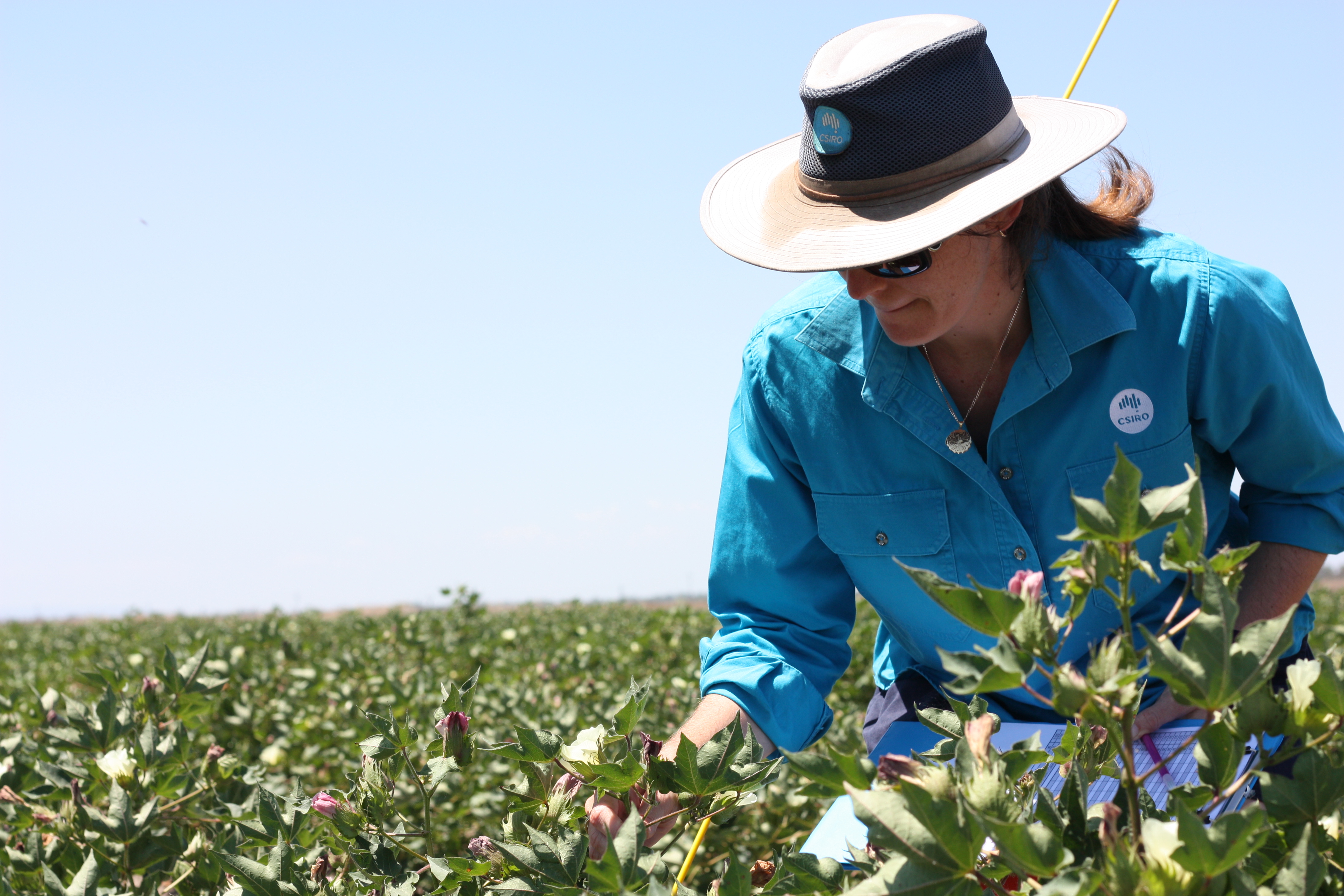
Plant breeding is a multidisciplinary science that underpins the agricultural sector and therefore global production of food, animal feed, fuel, and fibre.
The study showed that a large proportion of highly-skilled plant breeders are now reaching retirement age, and there is a generational gap for succession planning as university graduates opted to focus on other areas of plant science including molecular biology.
However, long-term solutions were proposed which included the establishment of dedicated training facilities in different countries, co-ordinated approaches between the public and private sectors, and increased promotion of the plant breeding sector.
The research was a collaboration between CSIRO, Lincoln University in New Zealand, and McGill University in Canada.
2 October 2024: Enhancing Fusarium crown rot resistance
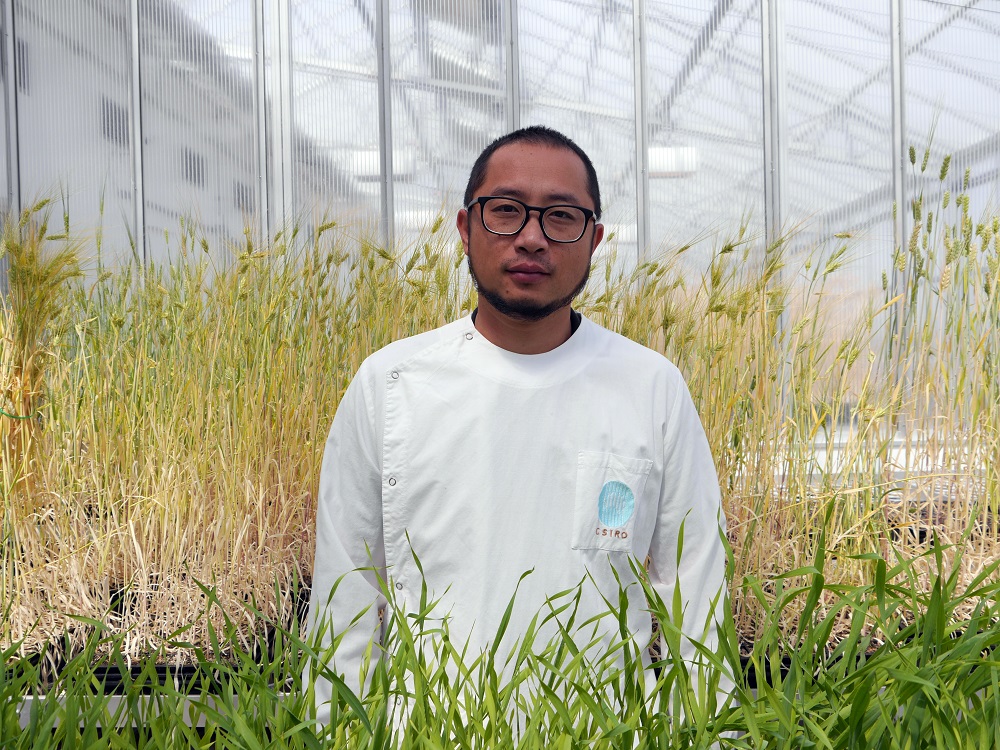
For over four decades, Fusarium crown rot has been a persistent issue for wheat and barley growers. Growing resistant varieties is one approach in managing the disease.
Dr. Zhi Zheng and his team works to develop genetic solutions to enhance resistance.
“We’re trying to improve the Australian germplasms without interfering with crop performance,” Zhi said.
Supported by investment from the Grains Research and Development Corporation (GRDC), the team has identified five loci that confer resistance to crown rot. Among these, two novel loci for Australian wheats stand out: Fhb7 and another on the 3B chromosome.
The team introduced the Fhb7 gene into Australian wheat varieties and crossed it with existing loci, creating pre-breeding lines and markers for breeding companies. As the project enters its final year, paired plot field trials are underway at research stations in Narrabri (NSW), Boorowa (NSW), and Forest Hill (Queensland). These trials compare yield loss between inoculated and non-inoculated plots to assess the effectiveness of the resistant gene.
Preliminary results from 2023 single row field trials are promising. Backcrossed lines with the Fhb7 gene have shown significantly higher grain yields in the presence of crown rot. The largest yield difference was observed at Narrabri with 11.4%, followed by Forest Hill with 8.7%, and Boorowa with 7.2%.
Zhi believes additional sources of resistance are needed to further improve Australian wheat and barley.
“This will provide breeders with a broader pool of resistance and tolerance, ensuring better crop performance and sustainability.”
13 August 2024: Farmers in Ghana get access to CSIRO-developed borer-resistant cowpeas
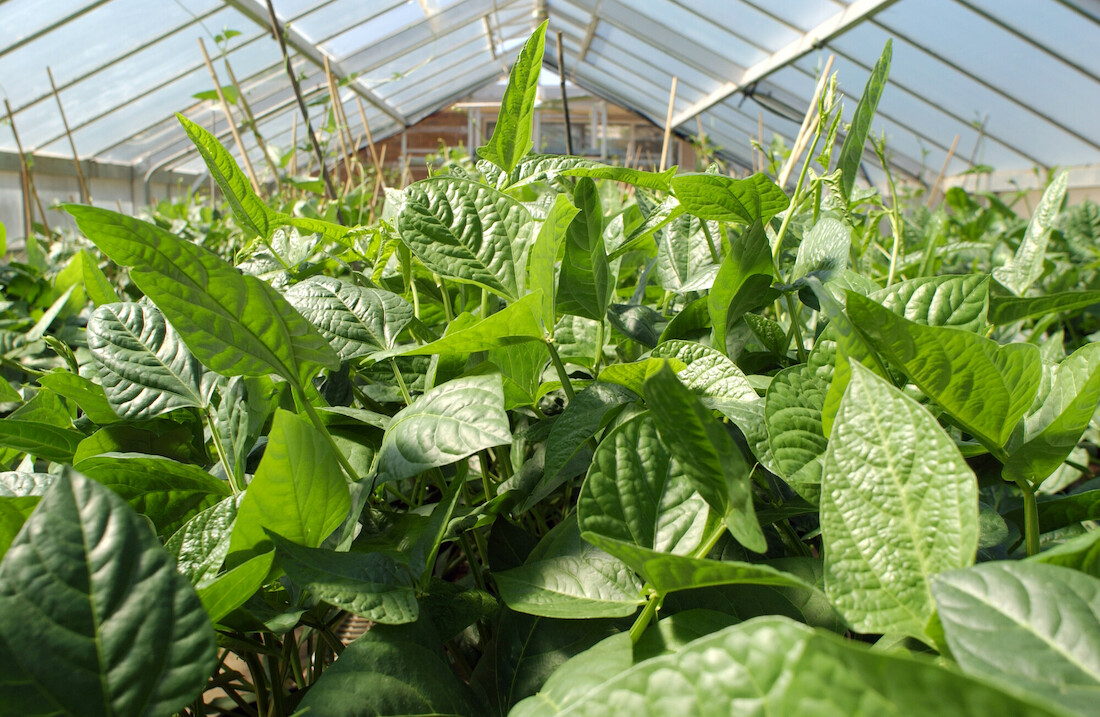 Cowpeas are a key protein source in Sub-Saharan West Africa, but their yields have been reduced by pod borer insects, which required pesticide use.
Cowpeas are a key protein source in Sub-Saharan West Africa, but their yields have been reduced by pod borer insects, which required pesticide use.
In collaboration with African and international research agencies, we developed pod-borer resistant cowpeas. Nigerian scientists further improved these cowpeas, which are now approved and grown by Nigerian farmers.
Recently, Ghana also approved these insect-resistant cowpeas, marking the first genetically modified crop in the country. This will help improve food security and reduce pesticide use in Ghana.
Read more about this news from the International Service for the Acquisition of Agri-biotech Applications and the Ghana News Agency.
19 July 2024: New dried grape variety Murray Bold attracting grower attention
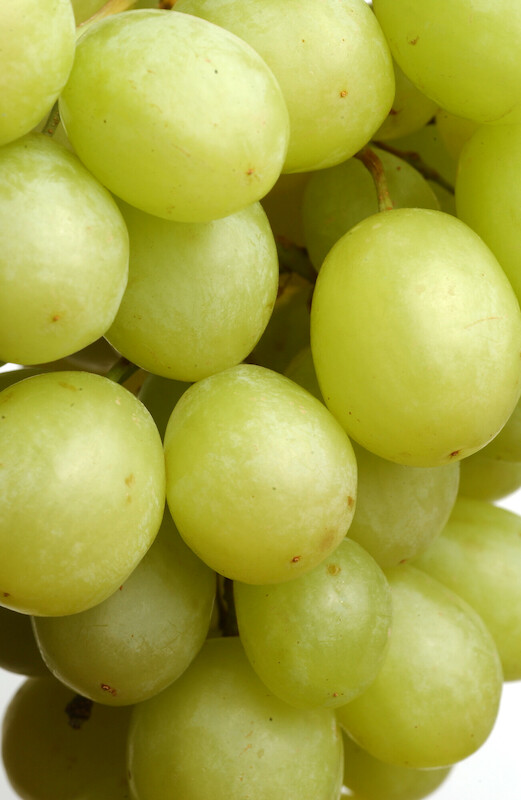 We have bred and released many new grapevine varieties for diverse product applications including dried grapes, wine grapes and table grapes.
We have bred and released many new grapevine varieties for diverse product applications including dried grapes, wine grapes and table grapes.
This year there is considerable interest developing, particularly in Sunraysia growers, for the newly released dried grape scion variety Murray Bold we developed.
The new Murray Bold variety was released under Plant Breeders Rights protection in 2023, and formally launched at the Secur Family Farm’s Merbein South Vineyard in 2024
Initial trials have shown the new variety to be high yielding . Most importantly it is rain resistant with non-splitting characteristics. Early ripening provides another option for managing risks of drying berries late in the season when conditions may be less favourable.
There is optimism that Murray Bold may offer an attractive alternative to established sultana varieties such as SunMuscat, a well-established dried grape variety also introduced by CSIRO to the Australian industry many years ago.
Growers are now able to access and evaluate Murray Bold under their own farm conditions and hopefully it will prove its worth for the industry overall. Read more in the North West Farmer.
18 June 2024: Sowing the seeds of rust resistance
Our Plant Pests and Diseases team have embarked upon a five-year, $10 million research program with The Sainsbury Laboratory, a subsidiary the Gatsby Foundation (UK), to bring rust resistance wheat to market.
This builds upon the success of previous work undertaken with the 2Blades Foundation, which used gene-stacking technology to deliver durable resistance to wheat stem rust disease.
This next phase focuses on creating genetically modified (GM) wheat lines that are ready for commercial release and deregulation. An important focus is overcoming international regulatory barriers for genetically modified wheat varieties.
Recent reviews of the regulatory environment suggest genetic modification using genes within the plant’s natural gene pool (also know as cis-genics) reduce the risk associated with commercialisation of GM wheat products.
Not only does the team hope to develop technology for multi-gene stacking for durable resistance in wheat, they also hope the research will extend to provide solutions to disease in many other economically important crops, like canola, soybean and maize.
7 May 2024: GPA-Nufarm ‘Paddock to Parliament’ Scholarship
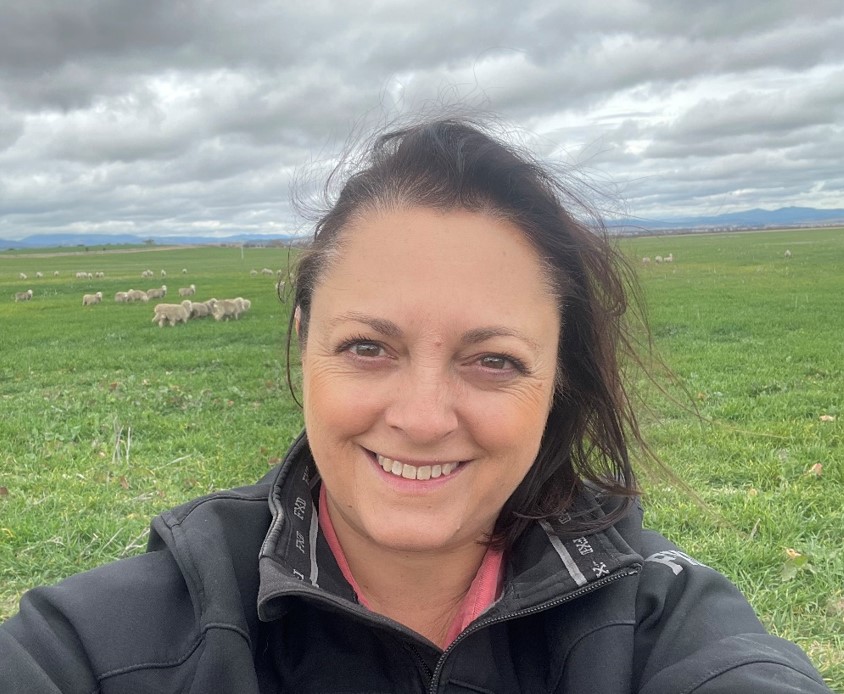 Grain Producers Australia (GPA) and Nufarm have teamed up to launch an exciting initiative aimed at cultivating the next generation of leaders within the Australian grains sector. Crop scientist, Dr Jess Hyles, took the opportunity to explore new horizons enabled by a Paddock to Parliament Grains Advocacy Scholarship.
Grain Producers Australia (GPA) and Nufarm have teamed up to launch an exciting initiative aimed at cultivating the next generation of leaders within the Australian grains sector. Crop scientist, Dr Jess Hyles, took the opportunity to explore new horizons enabled by a Paddock to Parliament Grains Advocacy Scholarship.
Jess has impressive balancing skill. She juggles a successful career as a research scientist with co-running a farm business in the NSW Southern tablelands alongside her husband and nurturing their family. It's no wonder that she eagerly accepted the personal growth challenges and prospects the GPA-Nufarm scholarship brought her way.
Jess took an active role in shaping a project that led her to travel to capital cities and regional hubs throughout Australia. She attended various industry events and meetings, forging connections with the innovative minds and entrepreneurs among the growers, as well as with industry advocates, crop breeders, investors, market specialists, and traders.
"I thrive on stepping out of my comfort zone and embracing new experiences,” said Jess
“It's been incredibly rewarding to immerse myself in a cause I'm passionate about and to bolster my confidence beyond my usual work environment."
Her journey culminated in a quintessential paddock-to-parliament moment when she joined the GPA Policy Council members at a special event in Parliament House.
For a deeper dive into this scholarship program and to follow Jess's ongoing journey and insights, visit the GPA website and read: Jess gets the Paddock to Parliament experience with scholarship.
28 March 2024: Academy recognises our early career researchers
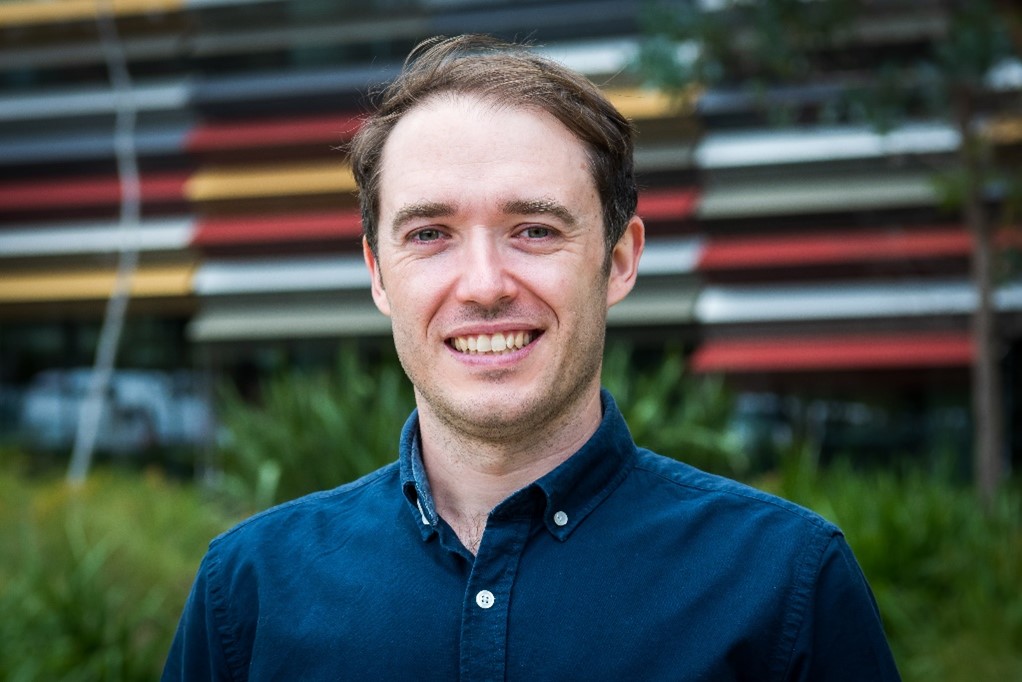
Congratulations to Dr Ricky Milne and Dr Megan Outram from our Pest and Disease Group who were recently awarded prestigious Thomas Davies Research Grant for Marine, Soil and Plant Biology grants for 2024.
The Australian Academy of Science oversees awards early career researchers (ECRs) these research grants from a generous philanthropic bequest from the estate of the late Thomas Lewis Davies.
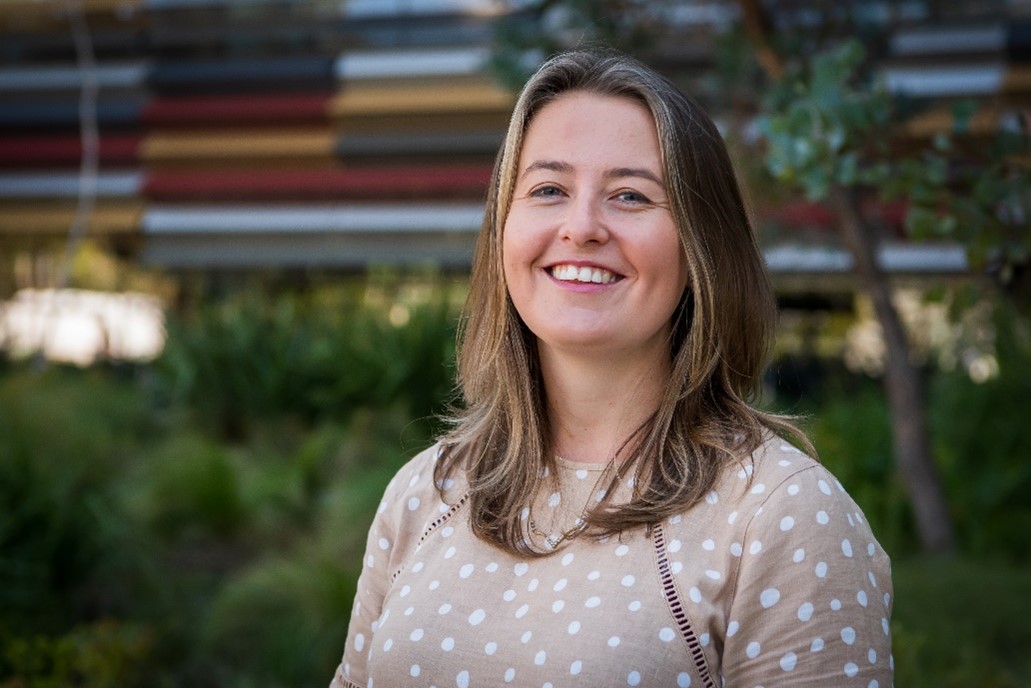
Ricky and Megan will use the funding to to boost their research efforts in generating new disease resistant crop plants.
Ricky is working on expanding the utility of a wheat gene that provides broad spectrum resistance to fungal pathogens
Megan is working to combat rust fungi that cause disease in crop plants by using a data-driven structural biology approach to customise 'resistance genes' to act of wide range of fungal variants.
These awards will contribute to our effort to provide a strong biosecurity foundation underpinning protection for Australian agriculture from evolving endemic and exotic disease threats.
22 March: Food Futures Symposium Advances Sustainable and Nutritious Food Production
On March 22, the Australian Academy of Science (AAS) hosted the Food Futures: Nourishing a Nation Symposium as part of Brisbane’s successful World Science Festival celebrations.
The symposium focused on the sustainability challenges facing Australia’s food systems, both domestically and in export markets.
Key topics discussed included:
- Climate change: The impact of adaptation and mitigation responses to climate change
- Supply chains: The fragility of supply chains
- Consumer choices: Shifts in consumer preferences related to diet, nutrition, and product affordability
The symposium featured five of our scientists, highlighting their national leadership role in developing science for the future of the national food system. These included John Kirkegaard and Greg Rebetzke (Crop Scientists), Di Mayberry (Livestock Systems Scientist), Gilly Hendrie (Public Health and Nutrition Scientist), and Rohan Nelson (Director of CSIRO’s Food Systems Horizons partnership with The University of Queensland).
These speakers meshed with a wide range of agriculture, food, nutrition and policy specialists from around the country. Each emphasised the importance of collaboration and interdisciplinary approaches to enhance the resilience of our food system.
Despite the challenges ahead, it’s encouraging that the AAS recognizes the critical role of ongoing excellent and impactful science in supporting sustainable and nutritious food production. This benefits not only the Australian community and environment but also the broader region and planet.
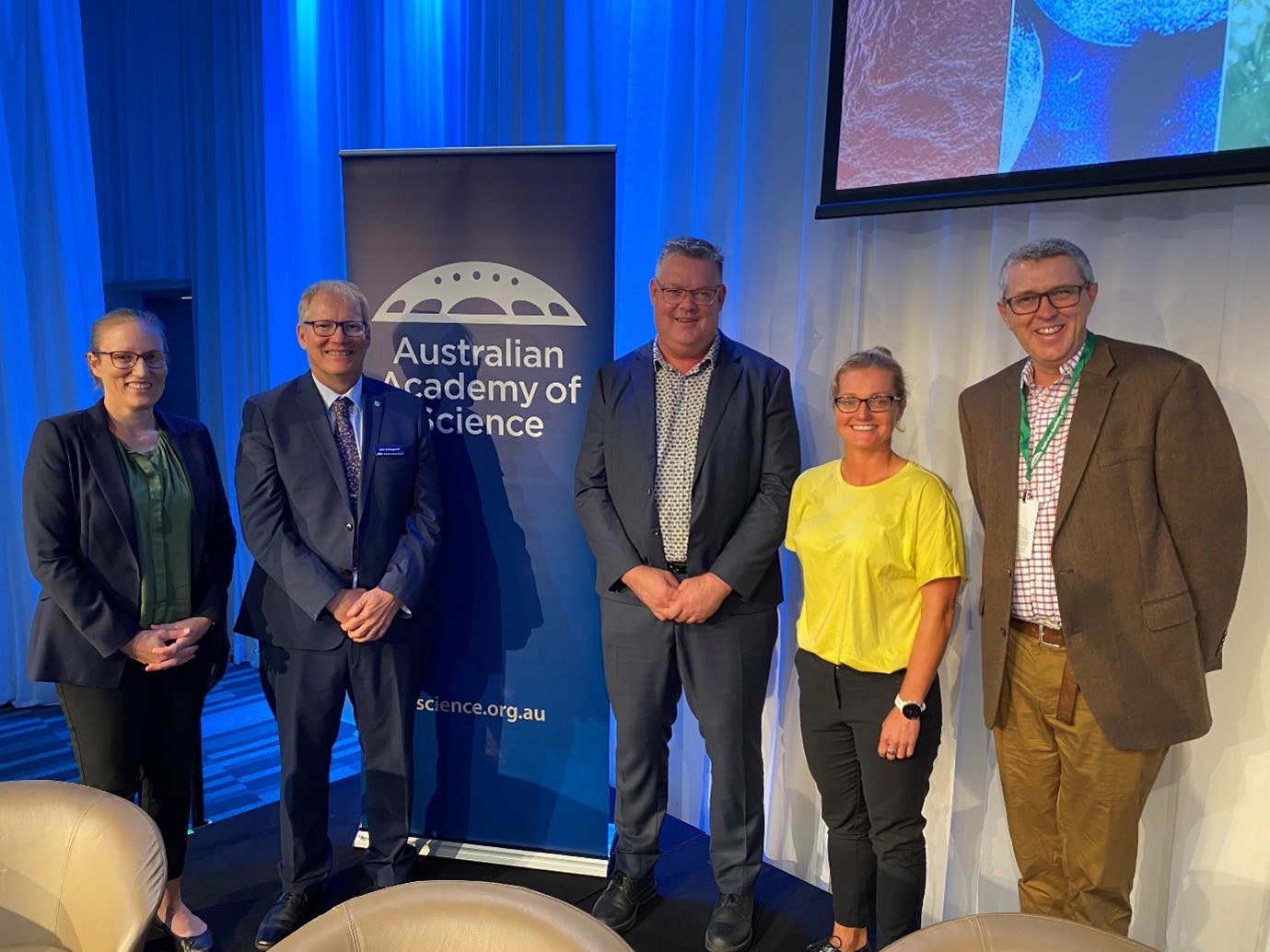
21 March 2024: Cultivating global perspectives through Nuffield Fellowship
2023 was a big year for Dr Vivien Rolland. He was recognised as the ACT Young Tall Poppy Scientist of the Year and was also the successful recipient of a Nuffield Australia Fellowship.

The Nuffield Fellowships provide a unique opportunity to travel domestically and internationally with other Fellows to learn more about global practices in farming and food production. It also provides an opportunity to grow personal and career perspectives to help improve local and global agrifood industries.
Now back and refreshed, Viv is keen to share with us some of his experiences and key learnings from his Nuffield Fellowship.
What attracted you to apply for the Nuffield Fellowship opportunity at this stage of your life and career?
The sense of purpose. We use our science to deliver innovation to the agrifood sector, and ultimately to the people who produce our food and fibre.
Nuffield was the perfect vehicle to better connect with people on the ground, in Australia and globally. To get exposed to, and learn from, a range of sectors and individual perspectives that no other development opportunity in Australia can provide at this scale.
Where did you go?
I did two five-week trips. The first one trip was to Canada and New-Zealand. I attended the 2023 Contemporary Scholar Conference in Vancouver, where all 85 new Nuffield scholars from 15 nations got together to connect, explore and discuss many facets of global agriculture. I then went to New-Zealand for the 2023 Nuffield Triennial Conference, where several hundred Nuffield scholars from all nations and past years get together. Both events included lots of farm visits. These were amazing opportunities to explore completely different facets of topics covered in talks.
The second trip was the Global Focus Program (GFP) which, as 2017 Nuffield Australia Scholar Stuart Tait describes, was ‘a whirlwind tour of global agriculture from top to bottom and left to right’.
My GFP took me through the bush of Zimbabwe, the post-Brexit pastures of England, the dry south of Spain, the gorgeous North of Italy, to finish at the Food and Agriculture Organisation (FAO) in Rome. There I was immersed in all-encompassing discussions at both the World Food Forum and the UN Committee on World Food Security.
Tell us a bit about the other Nuffield Fellow team members that accompanied you on your travels
On my GFP, there were 10 of us in total. In addition to me, there were four Australians with interests in viticulture and climate change, value adding in mixed farming, leadership coaching in rural communities, and rangeland regeneration.
Other colleagues included a Canadian rancher and a Japanese dairy farmer both looking at selling products directly to consumers. An Ag-consulting company CEO from New Zealand interested in how Ag consultants will evolve in the future. And and a Brazilian coffee farmer exploring opportunities for a carbon market for perennial crops.
I must say that when you talk about growing coffee or making gelato with your own milk and strawberries, everyone is very welcoming!
Looking back, what were the most memorable places and events you experienced?
That is a hard one. Everything was amazing in one way or another, and there were learnings to unravel everywhere.
In Zimbabwe, what was powerful was the resilience of the people we met, producing products in a challenging political, economical and historical context.
In England, it was particularly interesting to see how large historical estates are modernising by focusing on engaging and supporting community or by divesting from farming and regenerating the environment.
In Spain, it was fascinating to immerse yourself in a range of very traditional production systems linked to local cultural heritage (e.g. fighting bulls, olive oil, wild goose foie gras).
And in Italy it was interesting to reflect on the importance of Terroir (essentially the growing conditions of a location) and Controlled Designation of Origin (DOC) to produce food in specific regions (e.g. Prosciutto, Parmegiano-Regiano).
Provenance harnesses the power of stories and micro-regional identities built over centuries but it is now challenged by climate change which introduces new constraints in geographically-restricted production systems.
OK, the Fellowship is meant to be a learning and development experience, so what were the standout lessons for you and how has it shaped you as a person and a scientist?
That is a big question. There were fundamentally three types of learnings: technical, cultural and those about people. And agriculture is built off the back of these three facets, so it makes sense.
The technical learnings are too many to detail here and are partly covered by my previous answer.
The cultural learnings were unbelievable – I met hundreds of people in six vastly different countries, and the beauty of Nuffield is that it opens doors you would never be able to open on your own. Plus, in each country you are hosted by locals who share their kindness, passion, humanity, and some of their culture too. But the thing that stretched most people was that you are literally stuck with the same ten people 24/7 for five weeks at high pace.
You are always on the move, meeting amazing people and each minute of the day requires your full attention and engagement. It is not always easy but you learn a lot about yourself, how you interact with and care for others, and how you resolve conflicts and maintain a great team culture.
It’s also meant to be a fun experience – do you have an amusing anecdote from the trip?
It certainly was not when we got pulled over by Police three days in a row in Zimbabwe… It would have to be a couple of days later when we got chased by an ostrich!
Finally, what will you do differently in 2024 and beyond?
They say Nuffield turns your life on its head! But it’s probably too early to tell.
It is clear that Nuffield has broadened and deepened my appreciation for the real problems faced by food and fibre producers in industries and countries beyond those I am involved in.
It has strengthened my focus on impact and shifted my thinking towards a more holistic level.
Exploring and engaging with so many of the building blocks of the Agrifood world has helped me better understand how they interlock and has brought to the fore the idea that each coin comes with two inseparable sides which are part of the same story.
We need to listen, understand, and work together to build local solutions to global problems.
Thanks Viv and we look forward to seeing your future progress and success.
22 February 2024: Self-fertilising crops expertise featured in New Yorker.
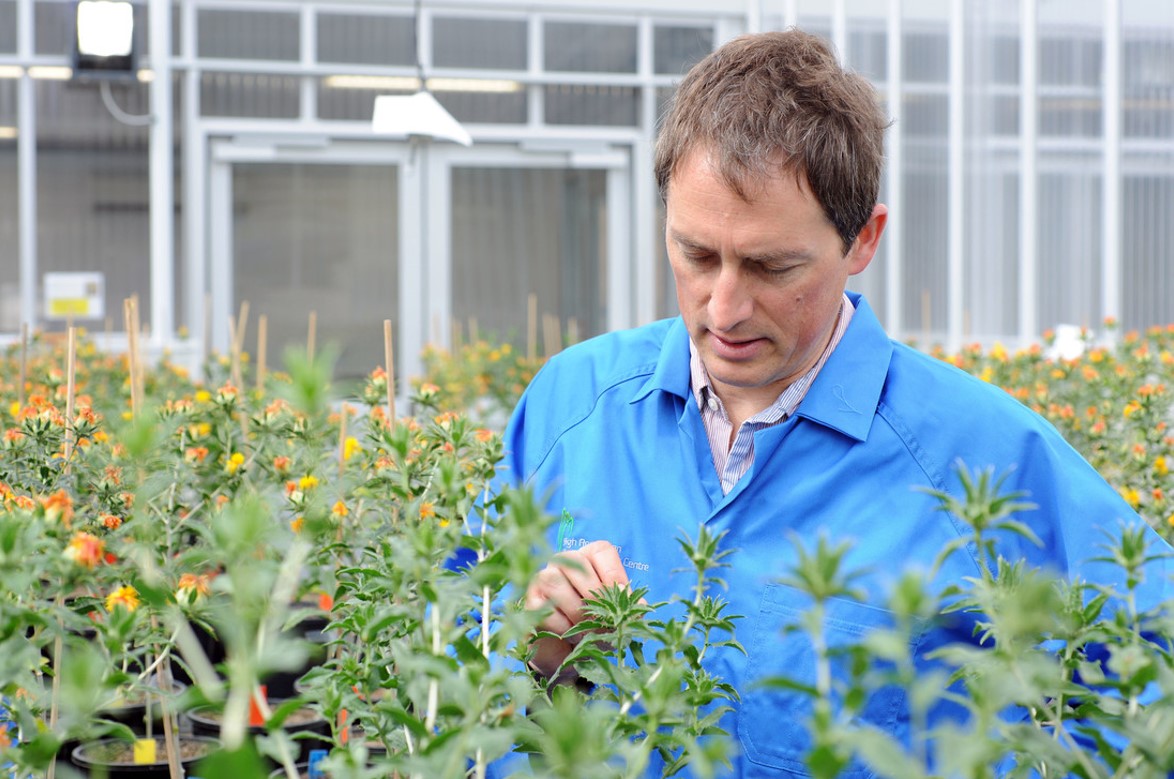
A recent article featured the New Yorker, titled: Will Plants Ever Fertilize Themselves? highlighted our work on engineering a novel nitrogenase enzyme that could enable crop plants to directly obtain nitrogen from the atmosphere.
This longstanding scientific challenge could revolutionize agriculture by allowing crops to grow without traditional nitrogen fertilisers. This novel approach could significantly reduce fertiliser costs for farmers and cut down greenhouse gas emissions associated with fertilizer production, transport, and use.
The article named new approaches aimed at engineering bacterial nitrogen-fixing nitrogenase enzymes to function in plants. Synthetic biologist Craig Wood, who leads our nitrogenase engineering team, featured in the story and gave an insight into the team's progress and pathway forward. He outlined our focus on engineering a novel iron-dependent nitrogenase that is targeted to plant mitochondria.
The attention from The New Yorker meant our research reached over a million readers worldwide and shows that our pursuit of sustainable farming is gaining global attention.
For those interested in a deeper dive, read Nitrogen for nothing and your protein for free which provides more information on our work.
29 January 2024: High-amylose wheat growing fast in Australia
A key component of a healthy diet is adequate fibre intake. Several years ago a research partnership of CSIRO, GRDC and Groupe Limagrain developed the novel high-amylose trait in wheat, resulting in grain with dietary fibre content up to ten times higher than that of conventional wheat grain. The trait has been commercialised via Arista Cereal Technologies, and in Australia a supply chain for high amylose wheat has been established with the cereal breeding company Australian Grain Technologies (AGT) and the milling company Pinnacle which also has export arrangements for the product with its Japanese parent company, the Nisshin Seifun Group.
Results for the second year of commercial production in Australia from AGT's first variety HAW1 are now being reported as approximately 9,000 tonnes, almost triple that of last year. The number of growers producing HAW1 has grown from 11 to 17 and production has now expanded from Victoria to also include South Australia. Growers are receiving a price premium for growing HAW1 and appropriate arrangements have been put in place to ensure grain segregation so that market requirements for such specialised grain are met. Further expansion is predicted for the future and new high-amylose wheat varieties are in the pipeline at AGT to provide better adaptation and yields.
In the USA high-amylose wheat and flour products is commercialised by Bay State Milling company and is now available in a wide range of food products, suggesting that similar market growth will eventuate for Australian based production. David Mattews is a contracted accumulator for Allied Pinnacle and you can read his comments on the rapid growth of high-amylose wheat in Australia and beyond in this recent article in Grain Central.
19 December 2023: Next decade of winegrape research takes root
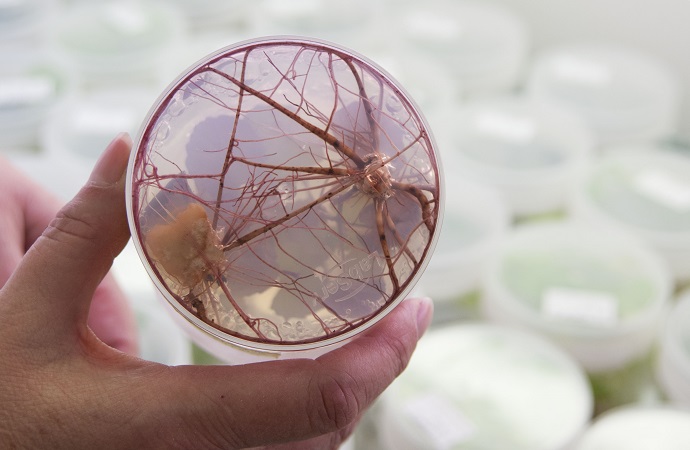
CSIRO's grapevine breeding team are continuing work with Wine Australia to answer some of the Australian wine industry's most pressing concerns.
In a continuation of a relationship that started over 30 years ago, our researchers are looking to utilise cutting-edge breeding technologies to develop outcomes such as gene-edited clones from established varieties, new varieties with unique quality and agronomic characteristics, and rootstocks that provide improved adaptation to Australian conditions.
The research agenda is the result of wide consultation with the domestic wine industry across the value chain. This has led to the development of a research vision, co-designed with industry, to inform the next decade of research. For more information on our work with Wine Australia visit their website.
4 December 2023: Award winning Legume Engineering Team
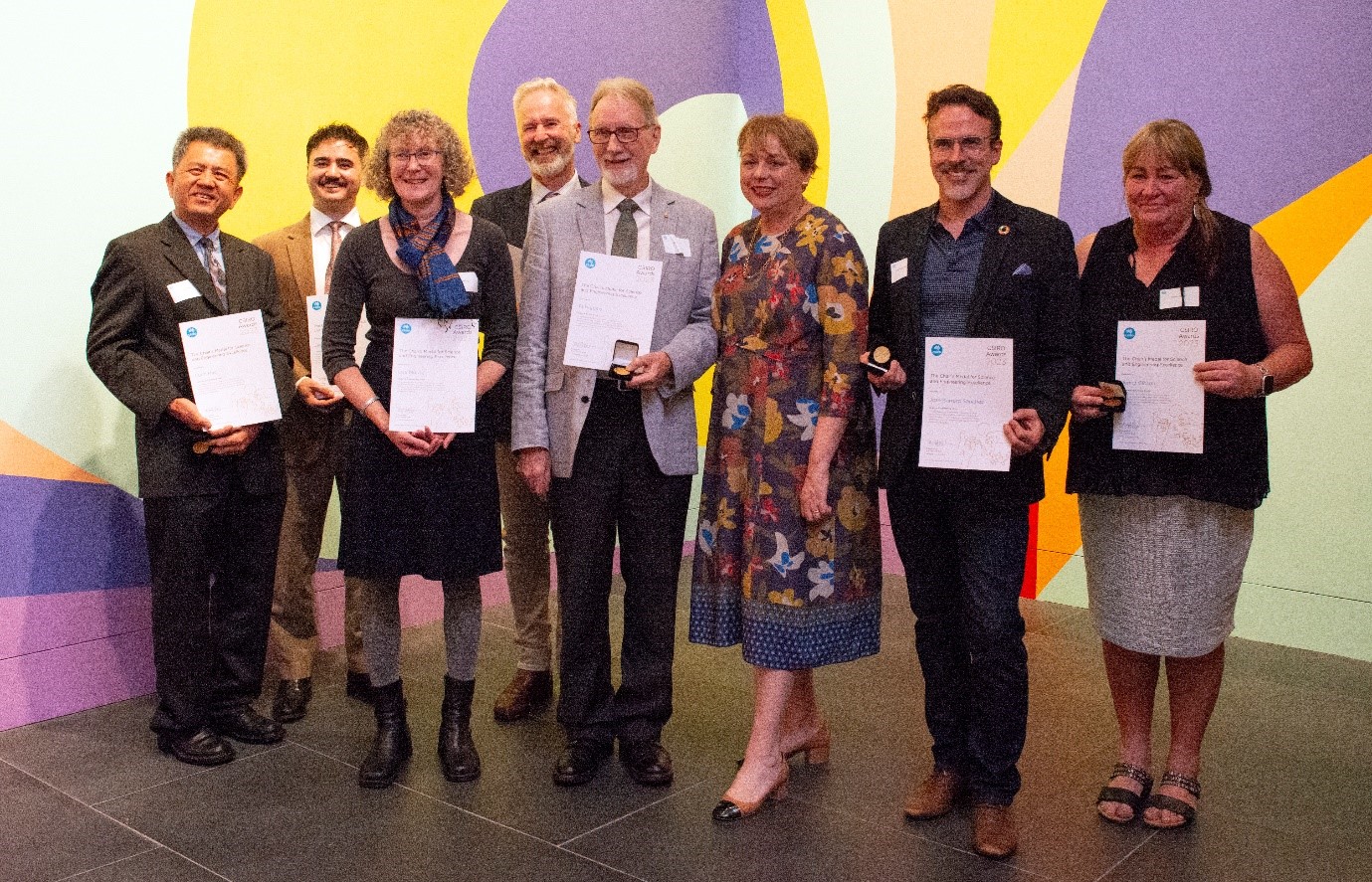
Success in developing Future Crops at CSIRO Agriculture and Food was recognised at the recent CSIRO 2023 Awards Ceremony with the Legume Engineering Team winning the prestigious Chair’s Medal for Science and Engineering Excellence. A big congratulations to the team members, TJ Higgins, Lisa Molvig, Andy Moore, Jose Barrero Sanchez, Luch Hac, Jenny Gibson and Javier Atayde. Cowpeas are a vital protein-rich food crop in West Africa and the team were responsible for developing pod borer resistant cowpea varieties now available to farmers in Nigeria and Ghana.
This novel technology brings food security and income for smallholder farmers and greatly increases yields while reducing the need for the use of potentially dangerous insecticides. Development and delivery of the insect resistant cowpeas developed at CSIRO was facilitated by an international collaboration involving African scientists, regulators and industry bodies as well as funding and technology inputs from agricultural institutions in the USA. Further information on the development and delivery of the insect-protected cowpeas can be found here.
28 November 2023: Next-gen talent for Future Crops
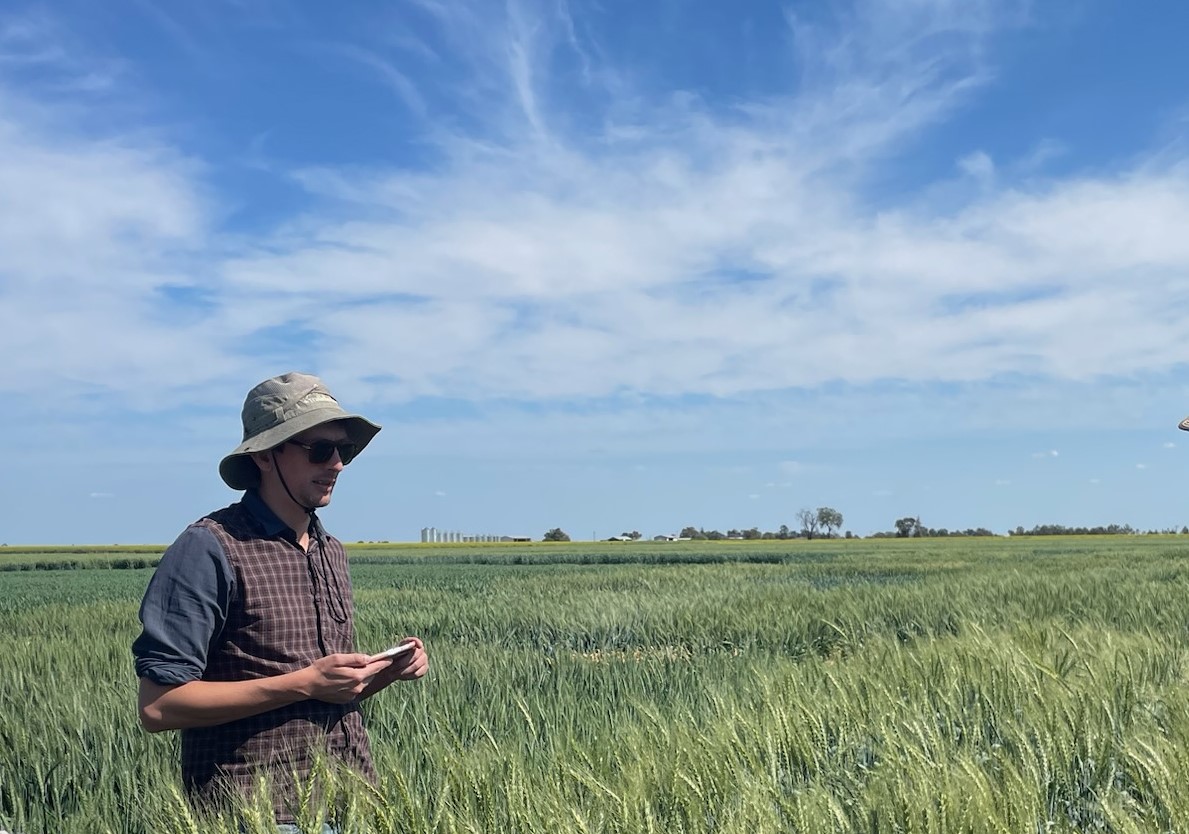
To continue to apply excellent science to Australia’s biggest challenges it is vital that CSIRO continues to attract the best international science talent to its laboratories and projects. In particular, top quality early career researchers such as postdoctoral fellows bring new ideas and energy to CSIRO’s projects. Dr Nick Fradgley completed his PhD at the University of Cambridge in the UK in 2022 in a joint industry-focused project with supervisors from the UK’s National Institute for Agricultural Botany (NIAB) and the cereal breeding company DSV UK. After an internship at the International Maize and Wheat Improvement Center (CIMMYT), Nick joined CSIRO earlier this year as a CERC Postdoctoral Fellow working in CSIRO Agriculture and Food.
Excitingly, in November 2023, The Genetics Society of the UK announced that Dr Nick Fradgley was the winner of the 2023/24 Sir Kenneth Mather Memorial Prize. This prize is awarded to a graduate showing outstanding merit in pure and applied aspects of biometric or population genetics. Nick’s thesis title was ‘Genetic control and prediction of milling and baking quality for UK wheat breeding’ and he explored applying quantitative genetics tools and models in a commercial wheat breeding programme to improve the prediction and selection of wheat milling and baking quality for future climates.
Now at CSIRO, Nick is working with a team led by Dr Jess Hyles to model genotype by environment interactions in long-term wheat multi-environment trial datasets to understand and predict adaption, and design future crops for Australian growing environments.
Nick is a fine example of the exceptional science talent that is recruited into CSIRO’s research projects, bringing highly credentialled science skills and industry knowledge to current research challenges that are focused on the Australian grains industry. You can read more about Nick’s award on The Genetics Society award webpage. Congratulations Nick!
23 October 2023: Homage for Flor’s ‘gene for gene’ model for disease resistance
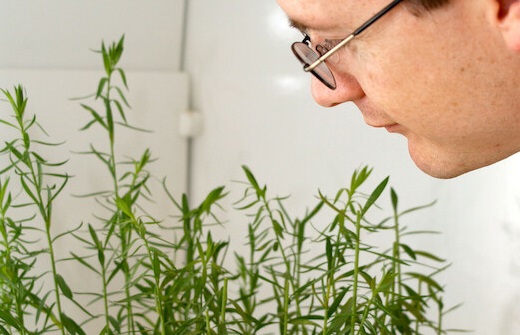
The gene-for-gene model that genetically explains plant-pathogen interactions was proposed by American scientist Harold Henry Flor based on his life's work with the rust fungus (Melampsora lini) of flax (Linum usitatissimum). Flor's model proposed that the inheritance of both resistance in the host, and virulence in the pathogen, is controlled by pairs of matching genes. This model has since been exemplified in many plant disease systems. To commemorate Flor's foundational contribution to plant pathology the field’s leading journal, Molecular Plant Microbe Interactions (MPMI), has established the H.H. Flor Distinguished Review where world leading scientists are invited to contribute. This year, CSIRO scientist Peter Dodds was asked to provide his personal perspective on the importance and impact of Flor’s work.
This is poignant for CSIRO because Flor's flax rust system was further developed by our scientists and led to the cloning of the flax L6 resistance gene, published in 1995. This was one of the first of a cohort of plant resistance genes cloned, in what was then a very competitive scientific race to explain Flor's model at the molecular level. Subsequently, multiple disease resistance genes in other plants, including Australia’s major crop wheat, have been cloned by CSIRO scientists and our collaborators.
The matching pathogen avirulence genes have also been identified and his has led to a highly refined molecular model at the protein structure level that explains how pathogens are recognised and resistance activated. These advances have opened new approaches to manipulate disease resistance in future crops.
9 October 2023: Peer recognition for cotton scientists
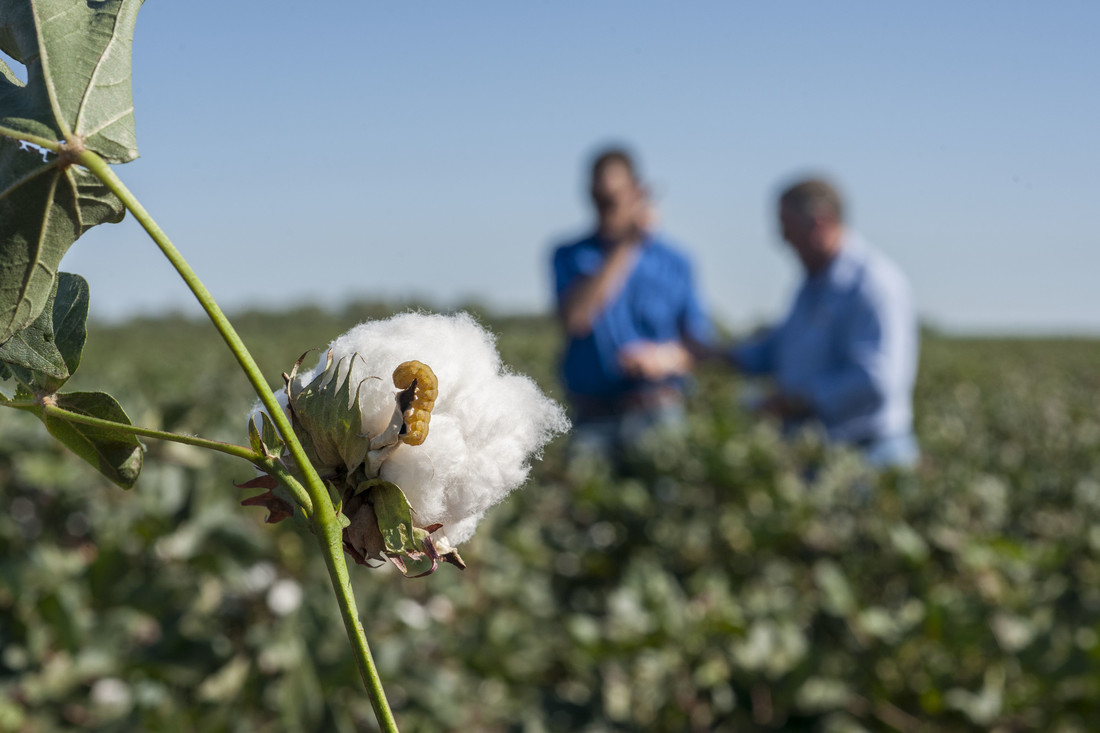
The Association of Australian Cotton Scientists (AACS) is an industry-supported association focused on maintaining scientific excellence underpinning impact and benefits for Australian cotton producers. The AACS 2023 meeting was held in Toowoomba in September and several awards were received by CSIRO scientists.
Dr Lucy Egan received the Early Career Scientist Encouragement Award for her work on developing disease resistant cotton germplasm as a member of the CSIRO cotton breeding program based at Narrabri. The AACS Scientific Publication Award was received by a Narrabri-based CSIRO research team together with co-authors from The University of Newcastle and NSW Department of Primary Industries for their paper entitled ‘Soil compaction in a new light: Know the cost of doing nothing – A cotton case study’.
Finally, Finally, Drs Lewis Wilson, Danny Llewellyn, Liz Dennis and Mary Whitehouse were awarded Lifetime Membership of AACS for their scientific contributions to the cotton industry. Congratulations to all and further information on AACS can be found on their website.
12 September 2023: Award-winning super-high oleic safflower oil
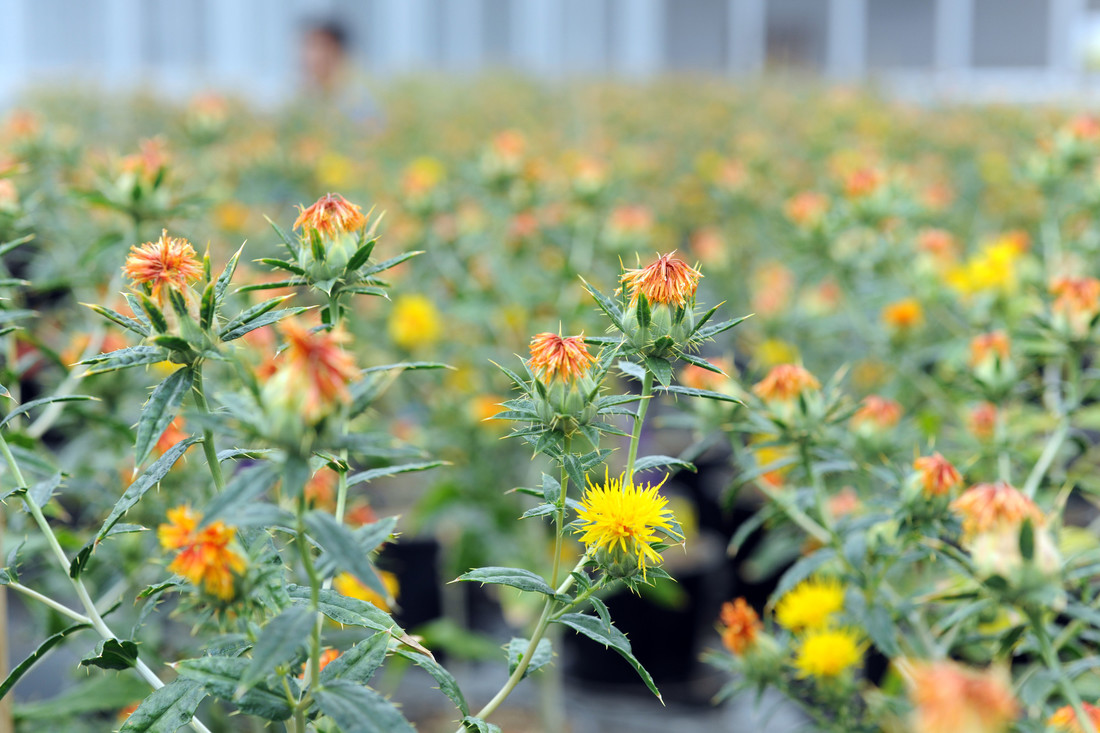
Super-high oleic (SHO) safflower oil is a novel plant oil developed in a research and innovation partnership between CSIRO and the Grains Research and Development Corporation. Plant gene silencing technology, developed at CSIRO, was used to modify the oil biosynthetic pathway of safflower so that its seeds produce oil with high levels (92-93 per cent) of oleic acid which provides high stability for applications in both the food and oleochemical industries.
A scientific publication from the CSIRO team describing this breakthrough can be viewed in a 2018 paper in The Plant Biotechnology Journal. SHO safflower oil is being commercialised by the Australian agricultural technology company GO Resources and oil for culinary purposes has been developed and marketed by the Australian company Plenty Foods and can now be found on some supermarket shelves. Recently, because of its novel health characteristics SHO safflower oil was announced as the winner of the best oil category amongst the 2023 awards of Healthy Foods Guide Magazine. More information on the award and the benefits of SHO safflower oil can be found on the Plenty Foods website [PDF · 4.2MB].
22 August 2023: Cool science to enhance chickpea production
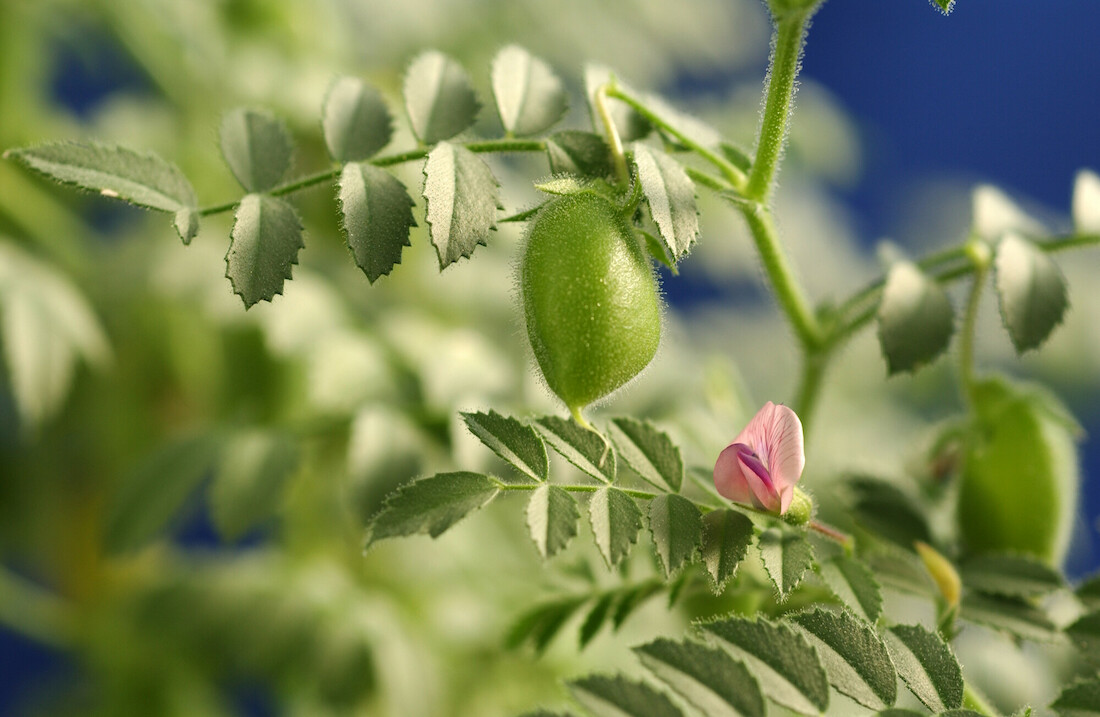
Increased production of chickpeas and other pulses will be important as a part of Australia’s contribution to meeting the predicted growing global demand for protein as described in Australia’s Protein Roadmap released last year. Growing chickpeas in regions, such as South-West Australia, that have a Mediterranean type of climate, would benefit from plant types that have greater reproductive chilling tolerance.
To this end, a team of CSIRO crop scientists based in Perth, with support from the Grains Research and Development Corporation (GRDC), have studied the role of vernalisation (chilling that induces flowering) in the phenology, growth and partitioning in domesticated chickpea and wild representatives of the chickpea genus Cicer in contrasting temperature regimes. While the wild material has more cold tolerance than domestic chickpea, both types can perform well under low temperature stress if they receive an early exposure to cold temperatures, regardless of their inherent vernalisation response. This is important because it demonstrates how the early sowing climate influences subsequent responses of chickpeas to cold. It also suggests that it will not be necessary to introduce a vernalisation response to chickpea when bringing in the cold tolerance from the wild.
This is good news because chickpea breeders are understandably reluctant to introduce vernalisation traits which are potentially undesirable for many Australian production environments. The team’s results have been published in Field Crops Research.
13 July 2023: Omega-3 canola oil aquafeed approved by Norway
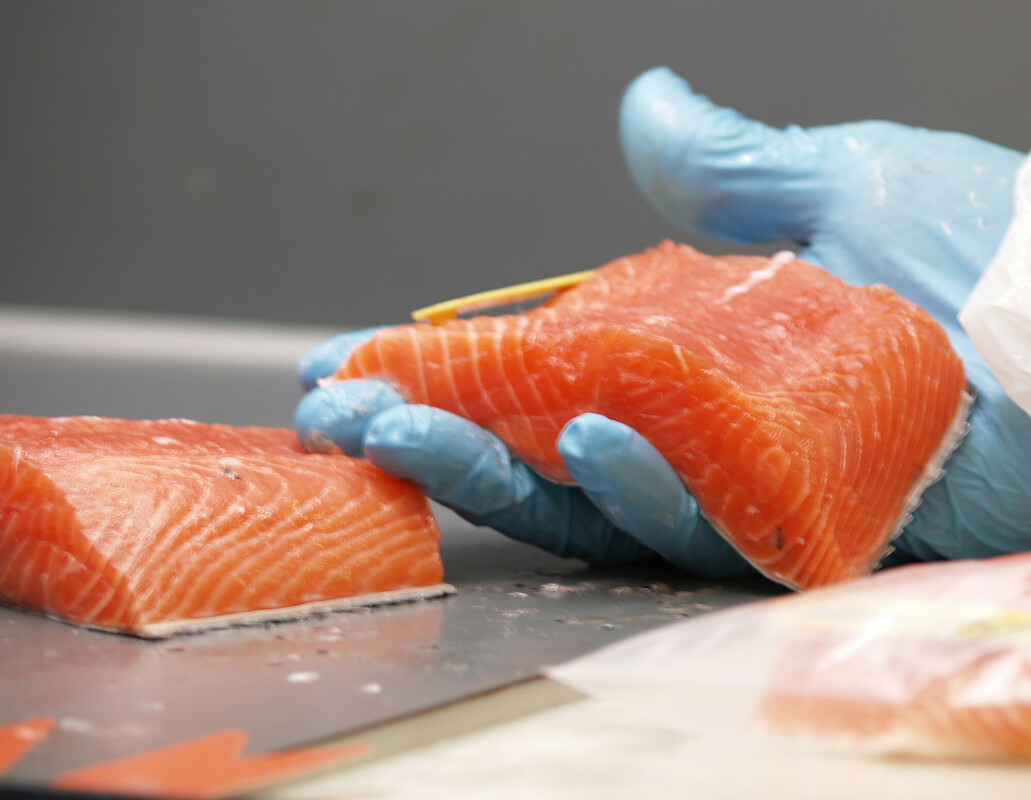
Canola that produces Omega-3 oil was developed in a partnership between CSIRO, NuSeed and the GRDC and is being commercialised for aquafeed by NuSeed under the brand Aquaterra®. The plant-based Omega-3 oil Aquaterra® provides a sustainable alternative feed ingredient for fish aquaculture which historically has relied on non-sustainable wild-caught fish as a source of Omega-3 oil aquafeed supplements which are important for fish development and nutrition. Norway is the world’s largest producer of farmed salmon, with total yields of approximately 1.6 million tonnes per annum.
In a recent major advancement, the use of NuSeed’s commercial Omega-3 canola oil aquafeed product Aquaterra® has been approved as safe for use in fish feed applications by the Norwegian Food Safety Authority (NFSA). The use of Omega-3 canola oil in global aquaculture will reduce pressure on wild fish populations and their ecosystems and will be critical in meeting the growing global human nutritional demands in a sustainable way. More information on the NFSA approval is available via the Aquaterra® website.
4 July 2023: Impact from CSIRO-bred cotton in North America
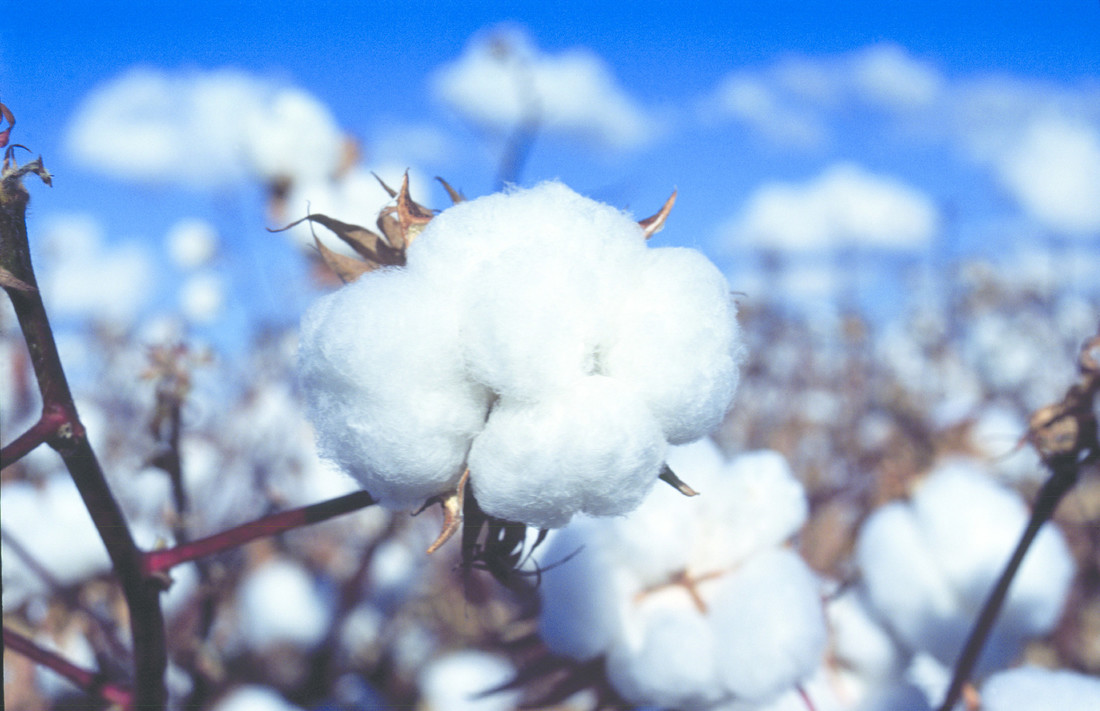
It is well known that CSIRO’s cotton breeding program has produced more than 100 varieties for Australian growers, consistently generating the world’s highest yields. In addition, CSIRO-bred varieties have also had significant impact overseas. The global reach of CSIRO-bred cotton varieties has been boosted as the 2023 cotton planting season in the USA and Mexico marks the first time that CSIRO varieties will be sold under the Deltapine brand, a Bayer CropScience (BCS) company. Deltapine is the largest cotton seed brand in the USA and the new CSIRO-bred variety, DP2335B3XF, will enhance their product portfolio, specifically for West Texas. An additional new CSIRO-bred variety, sold under the Amour brand as 9512B3XF, will also be sold in the USA in 2023. Amour is a brand of the WinField United Group, a major Agribusiness in North America with over 2,800 retail outlets.
The release of these new varieties builds on existing global sales of CSIRO cotton varieties under the FiberMax brand, now sold in six countries outside Australia. International partnerships with multi-national life science companies such as BCS have been critical for securing access to the insect pest resistance and herbicide tolerance traits that are crucial to effective cotton production in Australia. The success of cotton varieties both in Australia as well as globally is the result of both the efforts of its dedicated breeding team members and long-term focused research partnerships with industry, most notably Cotton Seed Distributors (CSD) in the Joint Venture, Cotton Breeding Australia. The release of these two new varieties in North America is acknowledged in CSD’s 2023 Annual Report.
6 June 2023: Salt-tolerant grain crops for Bangladesh
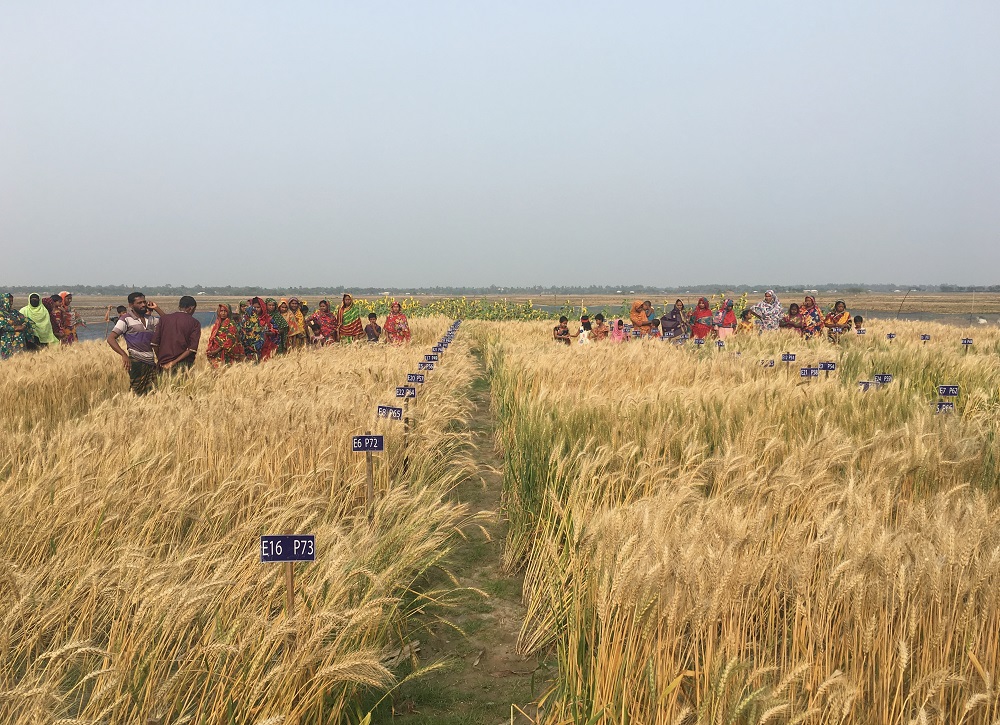
CSIRO science is delivering to help improve the livelihoods of farmers in Bangladesh. Richard James and colleagues at the University of Western Australia, who worked with Professor Willie Erskine, collaborated with scientists and wheat breeders in Bangladesh to develop wheat varieties with improved salt tolerance for southern Bangladesh. This ACIAR-supported project focused on testing wheat lines carrying the CSIRO salt tolerance Nax genes in a targeted wheat breeding program across a range of saline field conditions. A secondary objective was to train Bangladeshi researchers in developing screening protocols, improved field design and salinity characterisation methodologies, and an efficient, field-based framework for assessing and ranking wheat lines for salt tolerance.
The genes and diagnostic molecular markers were bred into a range of Bangladeshi wheat varieties and then comprehensively evaluated in the field over three seasons at nine trial sites varying in salinity. Evaluation of the breeding lines showed the salt tolerance genes reduced the build-up of sodium in the leaves of wheats containing the CSIRO-developed genes. A positive outcome was a 10-20 per cent yield improvement at high-salinity field sites. The Bangladeshi wheat breeders are now using the Nax genes in developing new breeding lines, some already included in advanced trials this year. A scientific publication has been accepted, highlighting some of the key findings from the project.
5 May 2023: Predicting flowering time in wheat
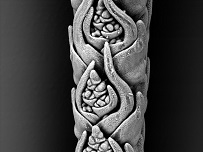
The flowering time of wheat crops in particularly important as seasonal stresses such as frost, low solar radiation, heat, water deficit and disease significantly affect yields if flowering occurs either too early or late. Accurate prediction of flowering time for wheat varieties in specific environments would greatly aid farmers optimise their yields. To this end a collaboration of cereal farming system and genetics scientists from CSIRO, La Trobe University, The New Zealand Institute for Plant & Food Research, Curtin University, The University of Melbourne and Field Applied Research Australia have studied the photoperiod and vernalisation responses of 69 Australian spring and winter wheat genotypes.
Flowering time in wheat is genetically controlled by five phenology genes at the VRN1 and PPDA1 loci and the wheat varieties studies were selected for diversity at these loci. Flowering times in spring genotypes were typically decreased by long photoperiod rather than vernalisation while the opposite was true for winter wheats. Sensitivity to vernalisation in spring wheats was mainly determined by a specific Vrn-A1 allele. The data from this study can now be used to develop a wheat phenology model to assist growers predict flowering time in wheat varieties for their environments. This work has recently been published in CSIRO’s journal Crop and Pasture Science.
27 March 2023: A disease resistance gene of wheat springs a functional surprise
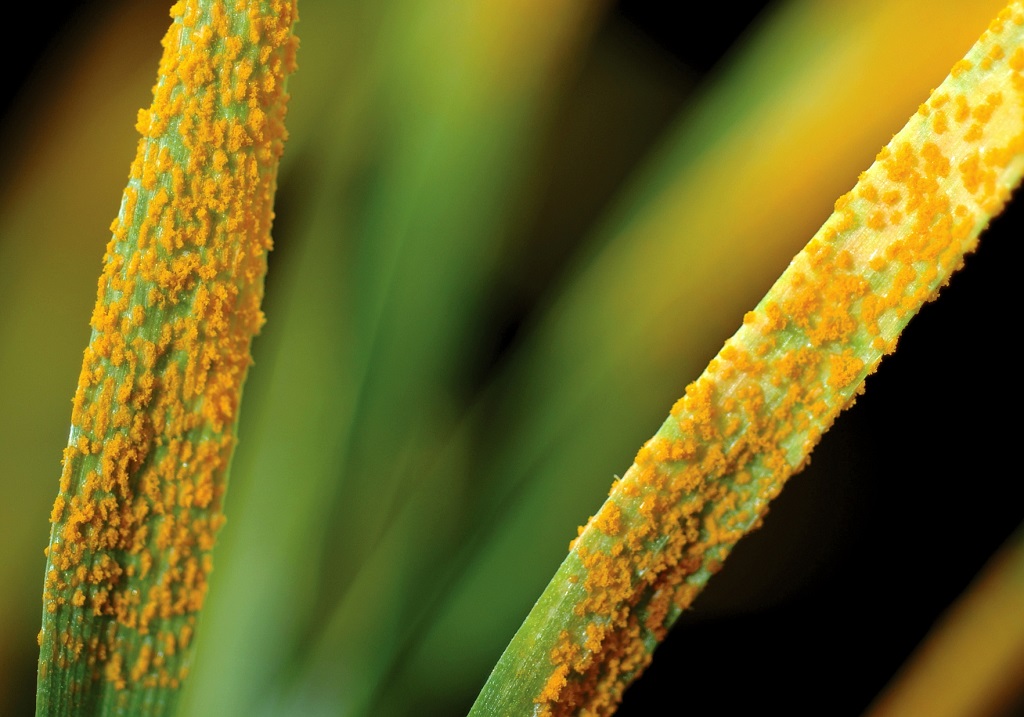
Most disease resistance genes in plants confer protection only against specific strains of pathogens. In wheat, some adult plant rust resistance genes such as the Leaf rust resistance 67 (Lr67) gene have been shown to confer resistance to multiple pathogen species, particularly biotrophs that do not kill host cells during infection. The cloning of the Lr67 gene was reported by scientists at CSIRO and collaborators in 2015 and its predicted protein sequence and structure strongly suggested that it functioned as a sugar transporter. In a recent publication in the journal Plant Physiology, a collaboration of CSIRO and the University of Adelaide and Western Sydney University has revealed a different and surprising function for the Lr67 protein.
Detailed membrane transport studies showed that the Lr67 protein acts a novel anion channel that would potentially perturb ionic equilibrium across membranes in wheat. Exactly how this function might contribute to disease resistance is yet to be determined but ionic fluxes have been implicated in plant immunity functions in other plants. The broad-spectrum adult wheat resistance genes such as Lr67 have proven to be very durable in the field and have so far withstood pathogen evolution to virulence. Understanding the mechanism of action of Lr67 is therefore important for future novel breeding crop protection strategies.
20 February 2023: New world-class facilities for CSIRO’s cotton researchers
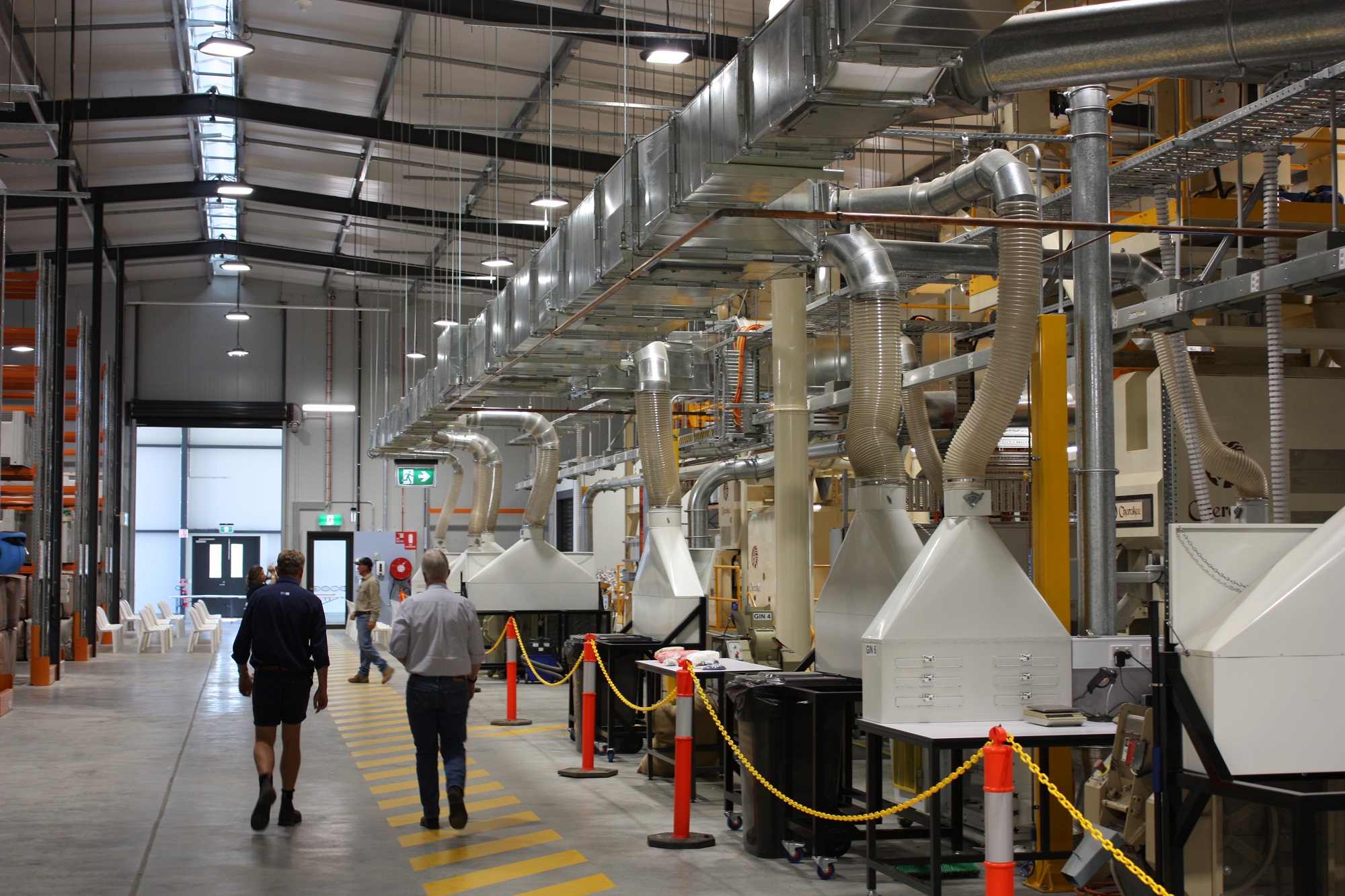
In February 2023, brand new upgraded facilities for CSIRO’s cotton research at the Myall Vale site were officially opened.
This $25 million infrastructure improvement will sustain the world leading industry outputs of CSIRO’s research teams in cotton breeding, cotton crop protection and agronomy into the future. Read the media release.
27 January 2023: Synthetic biology produces new dye-free pink cotton fibres
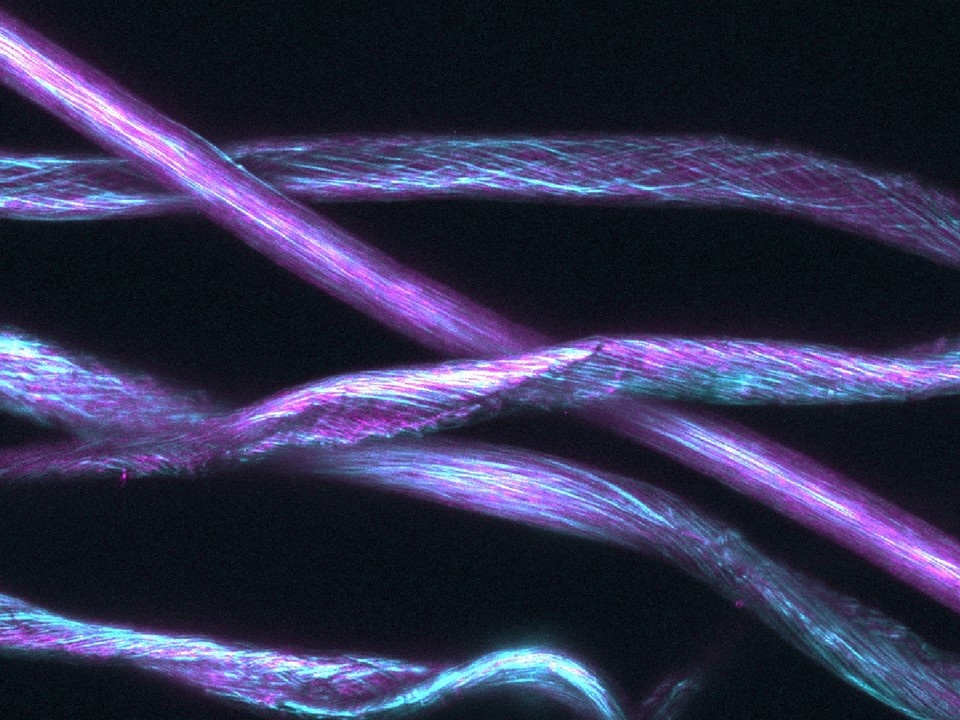
Cotton is a biodegradable fibre renowned to producing textiles that are comfortable to wear or use in homewares. Modern cotton varieties produce white cotton fibres in a boll that following post-harvest ginning and spinning processes needs to be dyed to produce coloured textiles. However, the industrial process of dyeing using synthetic chemicals is potentially harmful to the environment and human health. Thus, it would be very beneficial if post-harvest dyeing could be avoided by generating cotton plants that produce fibres that already have desirable colouring in them.
A few years ago, a project was initiated to do this within the CSIRO Synthetic Biology Future Science Platform and has achieved the first genetically engineered pink cotton fibres. The research was conducted by researchers in the Cotton Biotechnology Group of CSIRO Agriculture and Food based in Canberra and has just been published in a paper entitled 'Pink cotton candy'—A new dye-free cotton in the Plant Biotechnology Journal. In this work, three foreign plant genes that encode proteins of the biosynthetic pathway for the red pigment betalain were introduced into cotton so that they would be expressed in developing fibre cells. The resulting novel cotton plants produced aesthetically pleasing pink fibres demonstrating that the principle of in planta dyeing of cotton fibres is possible.
6 January 2023: Meet Sally Buck: Supercharging the plant-based protein industry
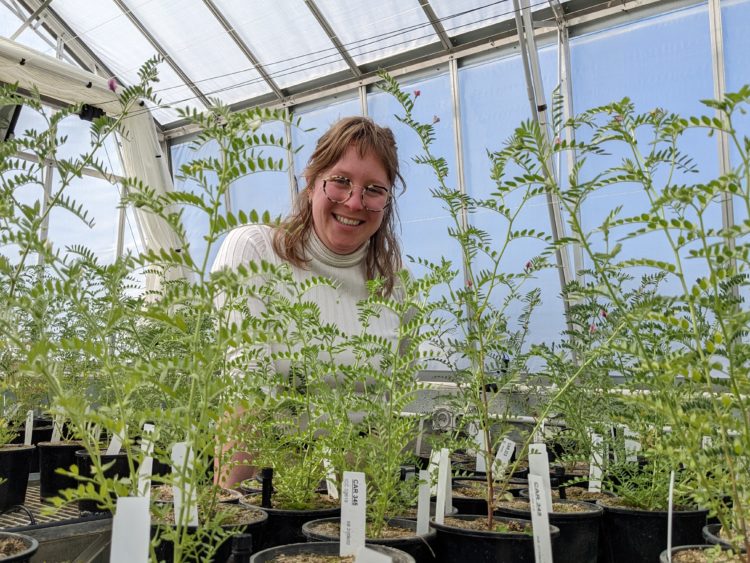
Dr Sally Buck discovered a passion for plant research and is now helping to feed the future.
She never dreamed of becoming a scientist when she grew up. But that was only because she didn't know it was an option. Now she's working on developing nutritious plant-based proteins as part of our Future Protein Mission.
Read more about her work and journey into a career in future crop science on the CSIROscope blog.
15 December 2022: Accolades for Liz Dennis and her team’s hybrid mimics in food crops
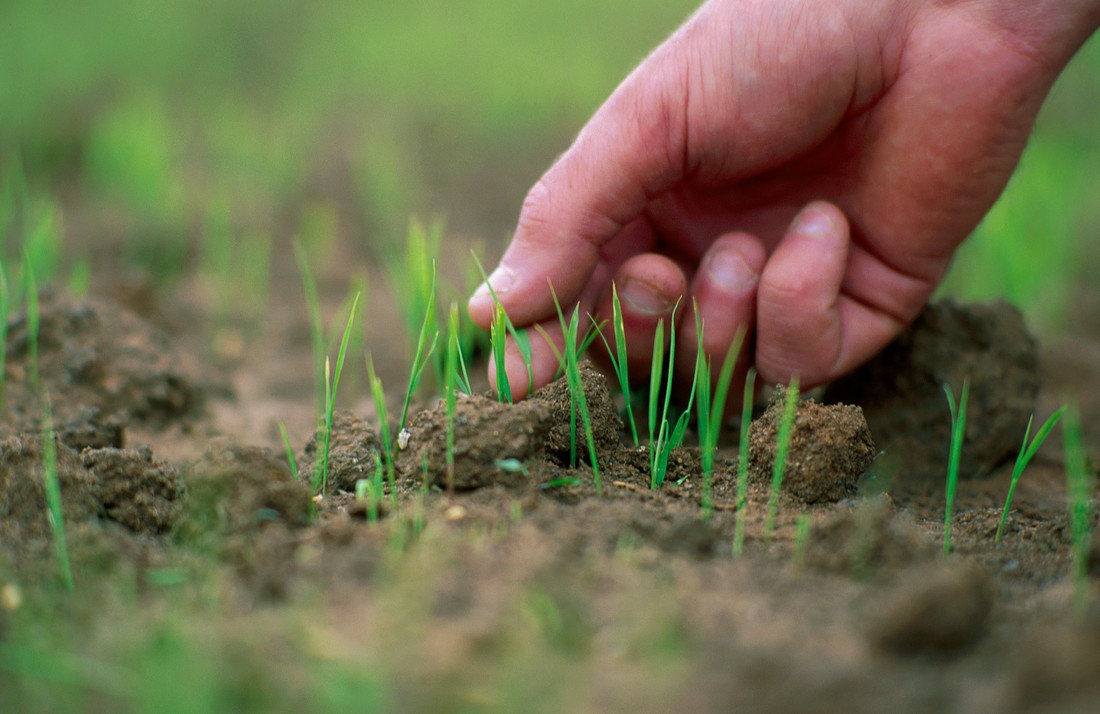
Liz Dennis, currently an Honorary Fellow in the Crops program at CSIRO Agriculture and Food, is one of Australia’s best known plant scientists and continues to generate exciting science advances for the future crops impact area. Liz has been awarded the 2022 Ruby Payne-Scott Medal by the Australian Academy of Science that recognises researchers of the highest standing in the physical or biological sciences and is among the most prestigious career awards that the Academy of Science presents. Liz, together with her long term and equally celebrated CSIRO colleague Jim Peacock, have been working on developing better ways to harness the large productivity gains that can be obtained through hybrid vigour in plant breeding. One of the complications of current hybrid breeding is that the yield benefits are obtained in the first hybrid generation but lost in subsequent generations. This means that new hybrid seed needs to be commercially produced using specialised germplasm each season and purchased by farmers, which is very problematic for small-holder farmers in developing countries.
A few years ago, in studies of the model plant Arabidopsis, Liz and her team reported that individuals that demonstrated hybrid vigour could be selected from subsequent selfed generations derived from hybrids. These plant lines were termed ‘hybrid mimics’ as they had the hybrid vigour phenotype but importantly the hybrid mimics could be propagated through selfing, meaning high yielding seed could be retained. This promising work needed to be translated into applications in food crops and in 2021, Liz’s team working with collaborators from The Sichuan Agricultural University, China and the University of Technology Sydney (UTS) published on the successful development of high yielding hybrid mimics of Japonica Rice, an important food crop. A new 2022 paper from this consortium, also now including NSW DPI, further elaborates on the mechanism that underpins the vigour of the hybrid mimic rice plants showing that photosynthesis-related genes were expressed in the hybrid earlier in development than in the original parents and gas exchange measurements indicated an early commencement of photosynthesis in the hybrid mimics. More recently, Liz’s team at CSIRO and UTS have published on the successful development of hybrid mimics of lentils, globally a very important protein crop. Liz has had an outstanding career as a plant scientist but the impact of the work of her team continues to shine.
9 December 2022: Danny Llewellyn wins the 2022 CSIRO Lifetime Achievement Medal
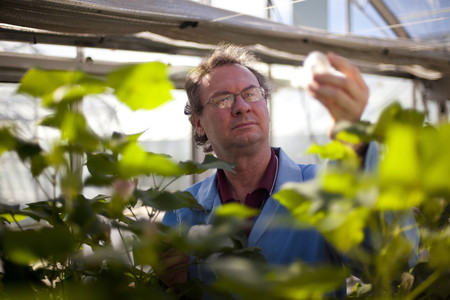
Danny Llewellyn has recently retired from CSIRO following a stellar career in molecular crop improvement research spanning 40 years. In recognition and celebration of his achievements Danny was recently awarded the 2022 CSIRO Lifetime Achievement Medal. Danny has made many advances in plant molecular biology during his career worthy of such recognition. However, most importantly Danny played a key role in CSIRO’s efforts to work with both the Australian cotton industry and multinational biotechnology companies to deliver genetically modified cotton varieties to growers that have increased resistance to devastating insect pests and increased tolerance to herbicides.
Adoption of these technologies in Australia has contributed to an 80 per cent reduction in insecticide use and 40 per cent increase in water-use efficiency over the past 25 years. This transformation of the cotton industry has been one of the most prominent agricultural success stories of Australia this century. In his acceptance speech Danny acknowledged his family and CSIRO colleagues, his mentors, his industry collaborators such as Cotton Seed Distributors Ltd and Bayer. He will be back to contribute to CSIRO as an Honorary Fellow and his legacy of impact is enormous.
24 October 2022: High Amylose Wheat is on the move to consumers
High amylose wheat (HAW) provides more dietary fibre than conventional wheat and was initially developed at CSIRO in partnership with GRDC and Groupe Limagrain. The HAW technology is now commercialised globally via ARISTA Cereal Technologies and in the USA, HAW products have been brought to market through the longstanding food ingredient company Bay State Milling. This company markets HAW via its HealthSense™ high-fiber flour product. Over the past two years, the use of HealthSense™ flour has expanded rapidly in the USA and it can now be found as an ingredient in many food products including pizzas, pasta, noodles, bagels, brownies, tortillas and ice cream cones. In a recent article in the industry media outlet, Food Business News, Mr Peter F. Levangie, the President and Chief Executive Officer of Bay State Milling, discussed how the company is innovating and partnering to market healthy high-fibre food products across the USA, and in doing so, disrupting many traditional food markets.
In Australia, Australian Grain Technologies (AGT) are licensed to breed and commercialise Australian-adapted HAW varieties. Important adjustments to wheat variety classifications have recently occurred that will facilitate the future marketing of HAW in Australia. Wheat Quality Australia (WQA) is the industry body that classifies wheat varieties to meet distinct quality attributes for processors and end users. WQA has now created a new specialty wheat classification, Australian Innovative Wheat (AIW), for varieties with unique quality attributes that are not represented in existing classifications. This new AIW class is described fully on the WQA website. AIW classified wheat varieties must match the following criteria:
- Meet a defined market opportunity, validated by at least one customer, in a food application.
- Demonstrate a unique and novel quality that is not available in the main classes and that performance against this quality can be used in future classification determinations.
- There must be a demonstrated net benefit across the whole industry to the acceptance of a variety into the AIW class, although in the short-term this benefit may accrue to a small number of participants.
HAW varieties would fit the new AIW classification and importantly, AGT have recently announced that a forthcoming HAW variety is the first wheat to be classified as AIW. More details are available on the AGT website. Health-conscious Australian consumers watch this space.
5 September 2022: Science advances from CSIRO-BASF collaboration on wheat yield published
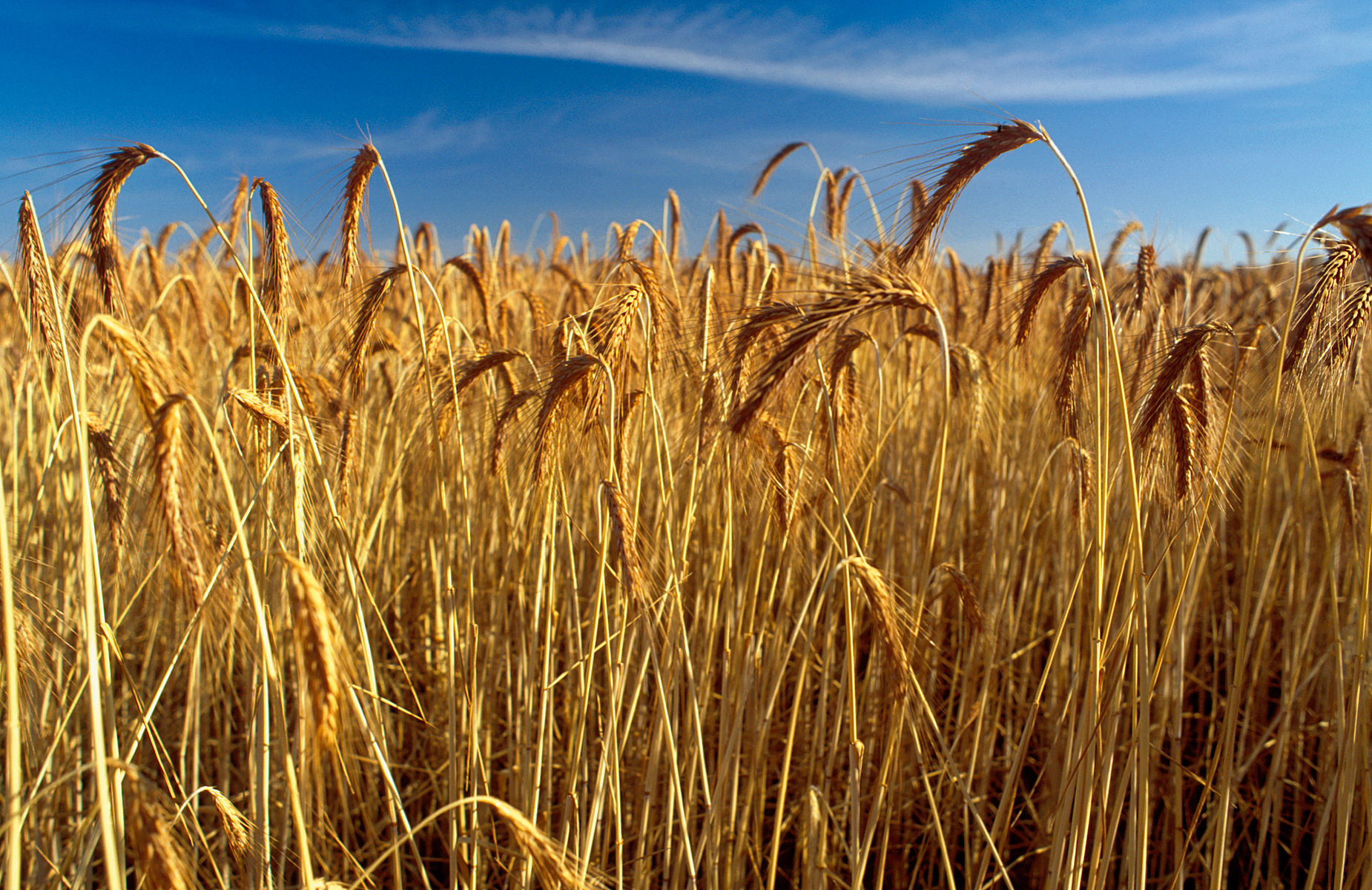
Novel findings from a collaboration of CSIRO with BASF on wheat yield components have been published in two recent papers. A publication in Plant Cell and Environment demonstrates that changes in light quality, specifically shifts in the Red:FarRed ratio that occur deeper in a canopy, are crucially important for limiting wheat yield potential. Studies of dense mini‐canopies under controlled conditions, showed that a high Red:FarRed ratio (due to lower Far Red) during spike growth and grain filling almost doubled grain yield, probably by disrupting the perception of neighbouring wheat plants. Further investigation under field conditions will be needed but this study suggests a novel future pre-breeding approach of selecting genotypes with different sensitivity to Red and Far-Red light to improve wheat yields.
In a separate study, CSIRO and BASF teams cooperated with researchers in the UK at The University of Cambridge and the National Institute of Agricultural Botany (NIAB) to identify and functionally demonstrate a critical role for a wheat gene in determining the number of wheat spikelets per spike (SPS) in the heads of wheat. Published in Scientific Reports, the research work initially used genetic mapping in MAGIC wheat populations, an approach for locating genomic control regions of traits previously pioneered at CSIRO, to identify the gene Wheat Ortholog of APO1 (WAPO1) at a locus that controls SPS. Functional validation of this gene as a control point for SPS was achieved in transgenic plants of both low and high SPS wheat genotypes. In the future, breeding for increased SPS may increase grain yield by increasing grain number in each wheat head.
25 August 2022: Genome sequence for breeding future protein lupins
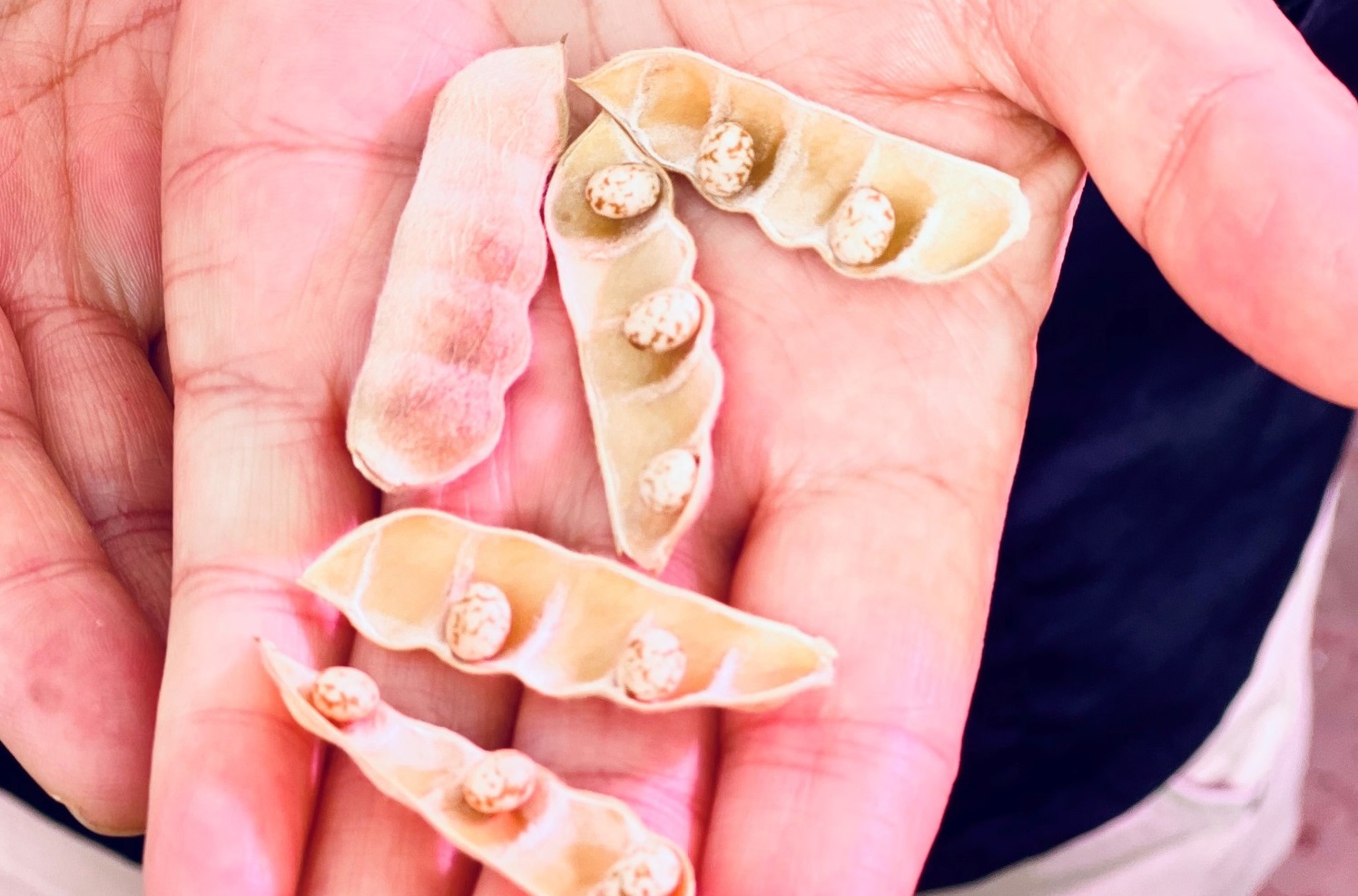
The narrow-leafed lupin (Lupinus augustifolius) has proven itself as a rotational legume crop in Western Australia and some other grain-producing regions. Its use is likely to increase in the future as its high protein content will be attractive in the growing global market for plant-based protein ingredients. In a landmark publication in The Plant Journal, Australian scientists from CSIRO, The University of Western Australia and Curtin University, together with collaborators from the USA, Denmark and China report a chromosome-length reference genome sequence for this important crop. The team also explored pan-genome variation across 55 diverse lines revealing many new features of the genetic landscape of lupins.
This new comprehensive genomic resource will boost lupin breeding programs aimed at increasing agronomic performance and product market value. More information is available on the emerging ‘Lupin Breeders Toolbox’ being developed at CSIRO.
23 August 2022: Nitrogen for nothing and your protein for free
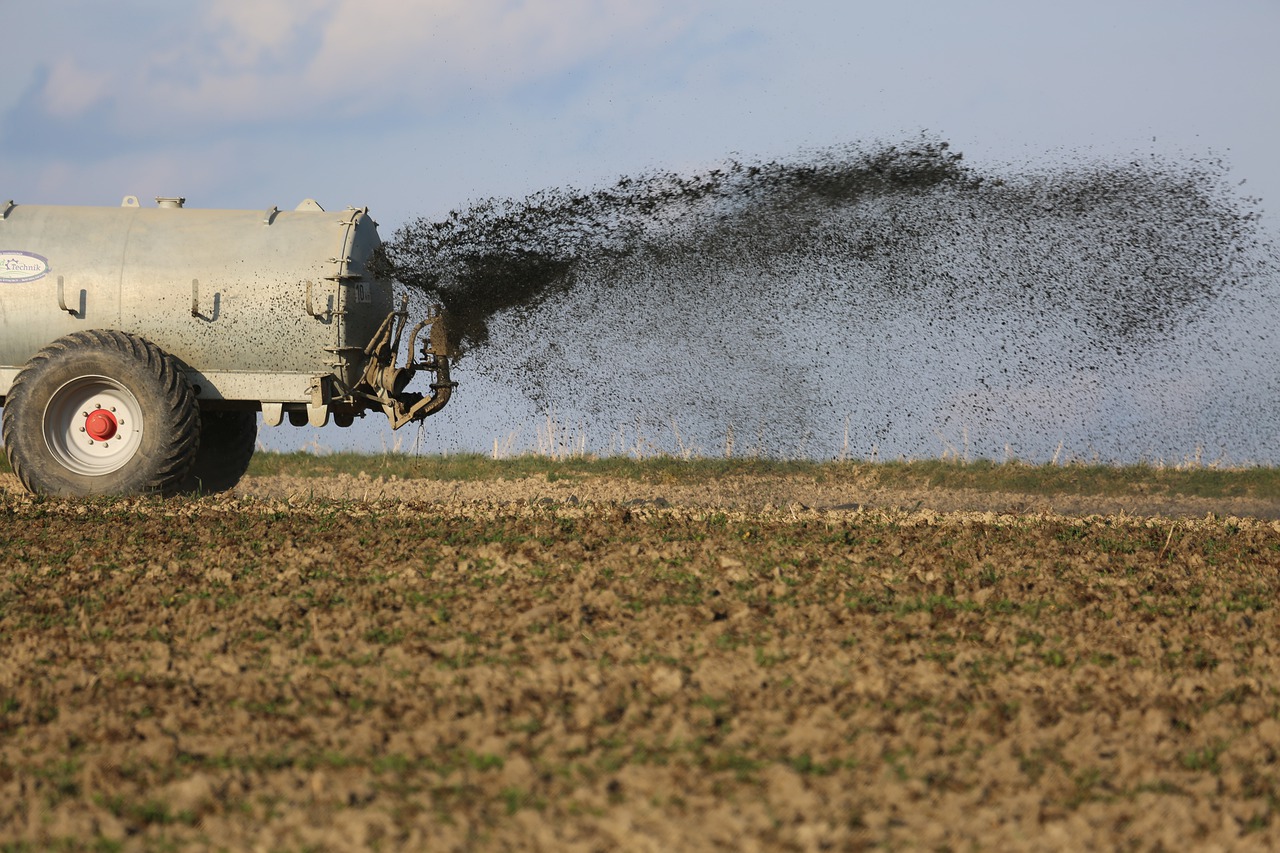
Nitrogen is key to producing the world’s crops – but it comes at a cost. New research from CSIRO is developing future crops that produce their own fertiliser.
A new CSIRO ECOS article by Anu Mathew discusses research that is looking at developing nitrogen-fixing crops to reduce the need for fertilisers.
18 August 2022: Kebari® barley taking off in Finland
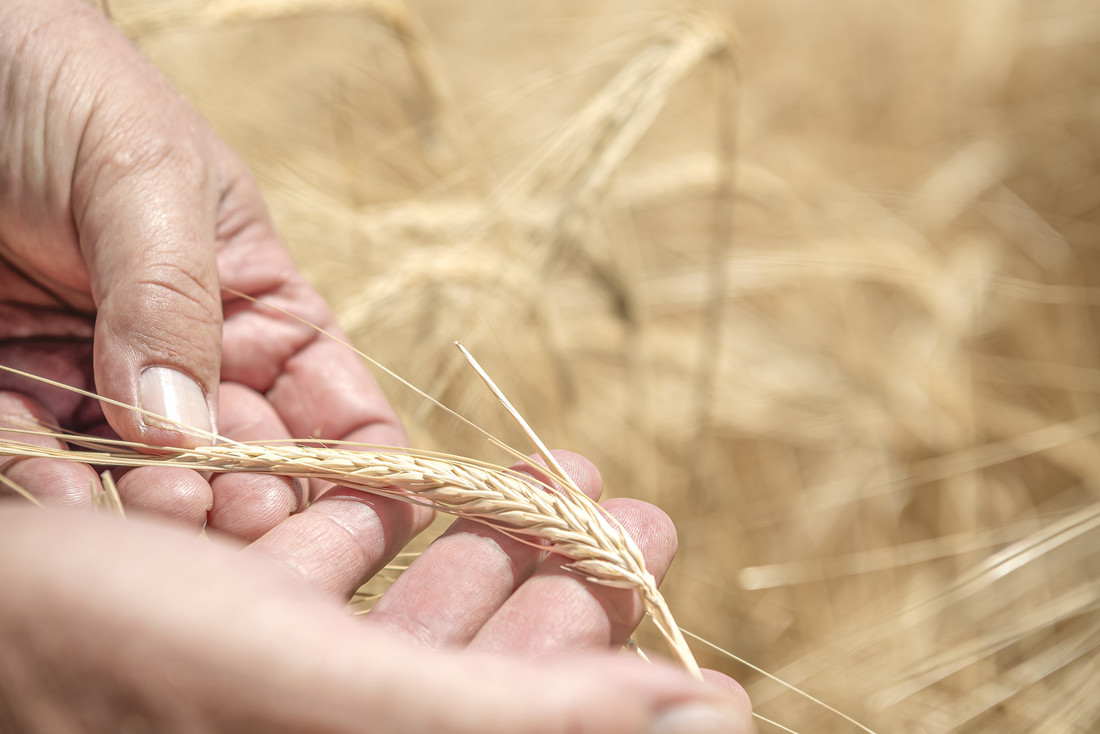
The Finnish companies FoodFarm and GoldenMalt that specialise in healthy plant-based food and beverage products are commercialising Kebari® barley varieties in Northern Europe via strategic commercial arrangements with the Australian company The Healthy Grain and CSIRO. Kebari® barley is notable because it produces grain with ultra-low levels (<5ppm) of gluten proteins and can be used either as a malting barley for brewing or as a hull-less barley for food products. Food and beverage products that use Kebari® grain instead of either conventional barley or wheat are well suited to consumers seeking to substantially reduce their gluten intake. FoodFarm has now announced that batches of Kebari are available for commercial product development trials in Northern Europe in 2022. These Finnish companies are also part of the international companies developing BarleyMax®-based products for high fibre health foods as discussed in another recent update. Further information is available via the Foodfarm website.
13 July 2022: Diverse healthy foods using BARLEYmax® continue to expand domestically and internationally
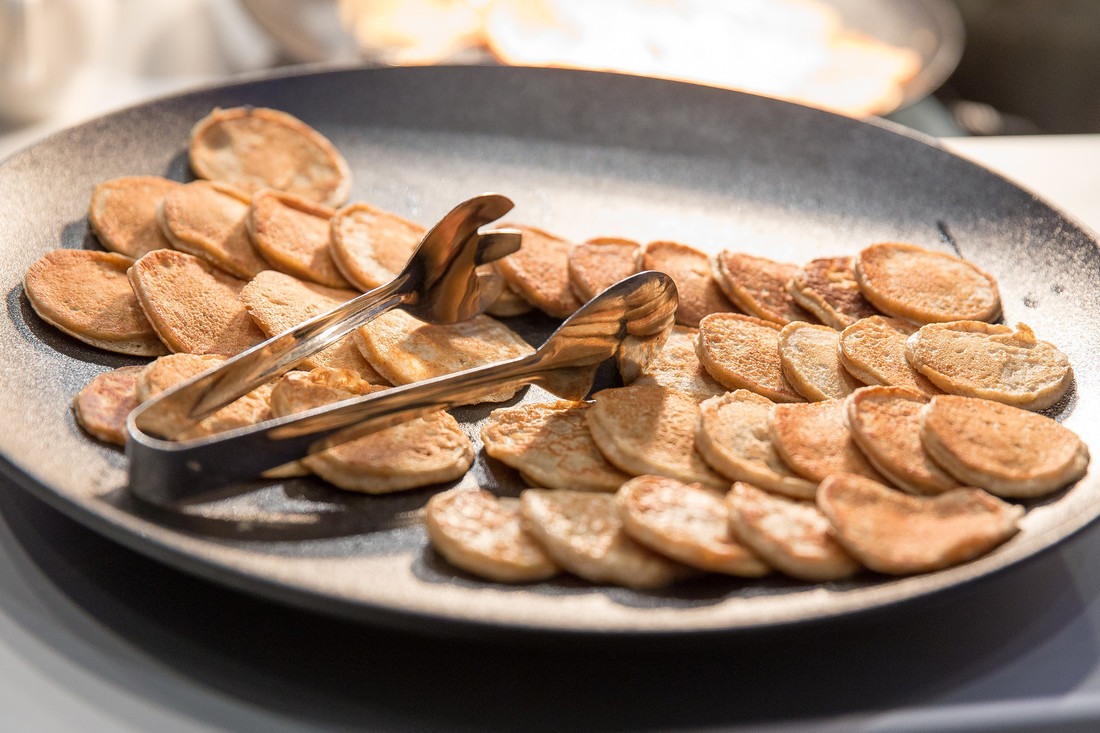
BARLEYmax® is a novel type of barley developed at CSIRO that has extremely high levels of dietary fibre and resistant starch which are important for gut health. BARLEYmax® was developed several years ago and has been commercialised through the Australian company The Healthy Grain. Because of their important health qualities, food products containing BARLEYmax® as an ingredient have expanded to a wide range products available in major supermarkets and other outlets . You can see the recently updated domestic food product range on The Healthy Grain website.
In addition, BARLEYmax® has been available in Japan for a five years via the food company Teijin and international product and market expansion is now also progressing more broadly through key overseas agents appointed by The Healthy Grain and is trading in New Zealand, North America, the United Kingdom and the European Union. The future continues to look bright for this agri-food innovation from CSIRO.
23 June 2022: Field resistance to Fusarium crown rot and grain yield gains in new barley lines
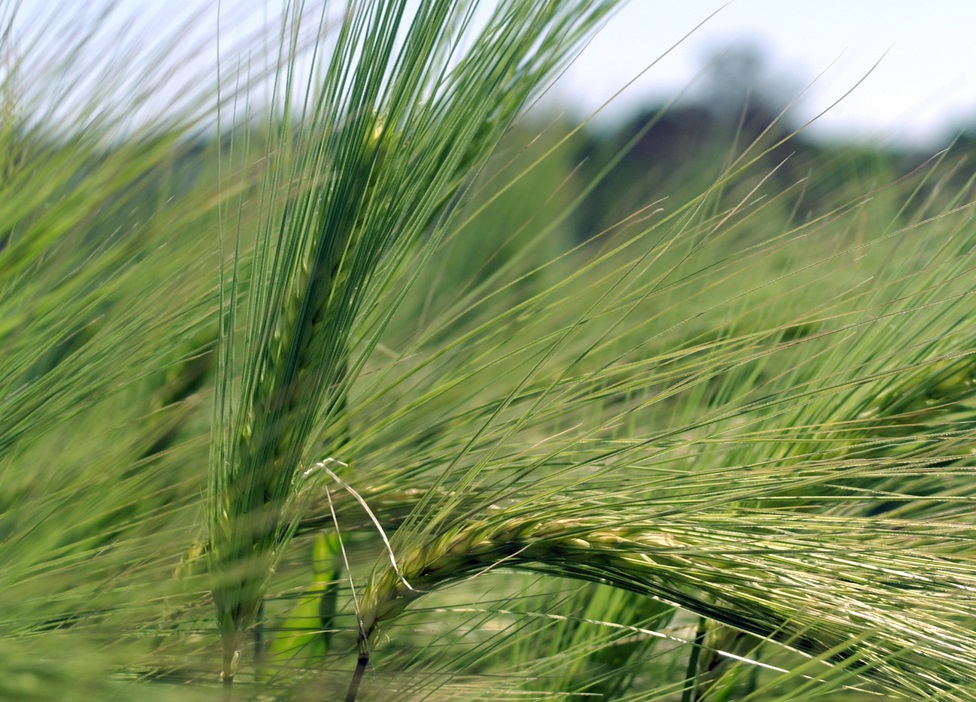
Fusarium crown rot (FCR) is an important soil and stubble-borne disease of both wheat and barley in Australia particularly in the northern grain belt and is prevalent in other semi-arid production cereal regions globally. The quantitative assessment of FCR disease is difficult because infection and symptom development are sensitive to environmental variation. Thus, screening for resistance and genetic analysis is usually undertaken in controlled growth facilities such as glasshouses but this leaves relevance to the conditions in farmer’s fields in doubt.
The Brisbane-based CSIRO team working on FCR in barley has previously demonstrated genomic regions, or quantitative trait loci (QTL), for resistance in glasshouses and had developed refined genetic material to study the impact of the QTLs on infection. Now in a GRDC-funded project, the CSIRO team as a part of a large collaborative effort with The Universities of Tasmania, Sydney and Southern Queensland as well as the Queensland Department of Agriculture and Fisheries, have shown that two of these FCR-resistance QTLs provided substantial resistance to FCR in field trials and significant increases in grain yield in paddocks where FCR is prevalent. The best new barley lines had yield increases of approximately 34 per cent over commercial varieties in FCR-infected fields. View the paper in the journal Agronomy.
20 June 2022: Super high oleic safflower oil is having an impact
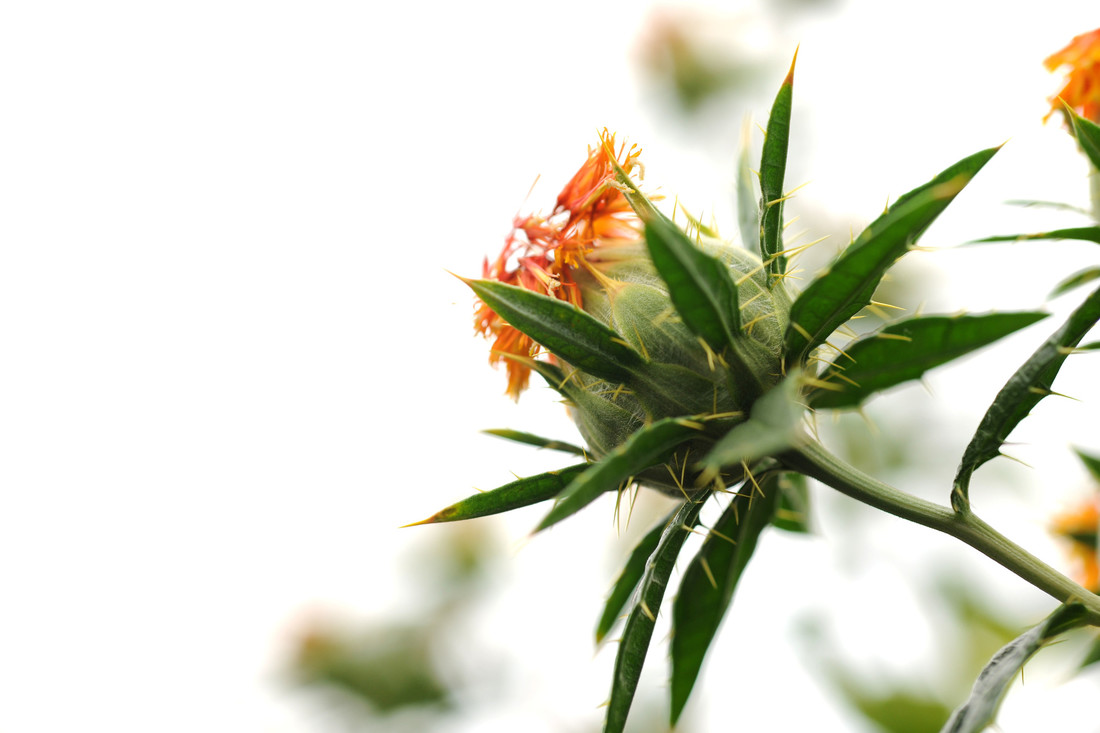
Super high oleic (SHO) safflower was developed in a partnership between CSIRO and the GRDC and is being commercialised by the Australian and Melbourne-based ag-tech company Go Resources. A recent article in GRDC’s Groundcover has indicated that strong market demand is building for SHO safflower oil for industrial lubricant and transformer oils as substitute for palm and crude oil which are less desirable. Groundcover reports estimates that 12,000 Ha of SHO safflower will be grown in Australia next season.
The future of the primary production of SHO safflowers is likely to get a boost in Western Australia where about 3,000 Ha are expected to be planted following production trials conducted by SLR Agriculture that produced yields beyond expectations. The CEO of SLR Agriculture said on ABC Country Hour Western Australia that SHO safflowers will provide a resilient and valuable break crop for the hostile soils encountered in WA.
SHO safflower oil is not only for industrial uses and its high temperature heating characteristics are important for a new commercial cooking oil that is now available from Plenty Foods branded as ‘Heart smart safflower oil’. This product has received a favourable review from well-known nutritionist Catherine Saxelby at FoodWatch.
8 June 2022: Iain Wilson recognised as CSD 2021 Cotton Researcher of the Year
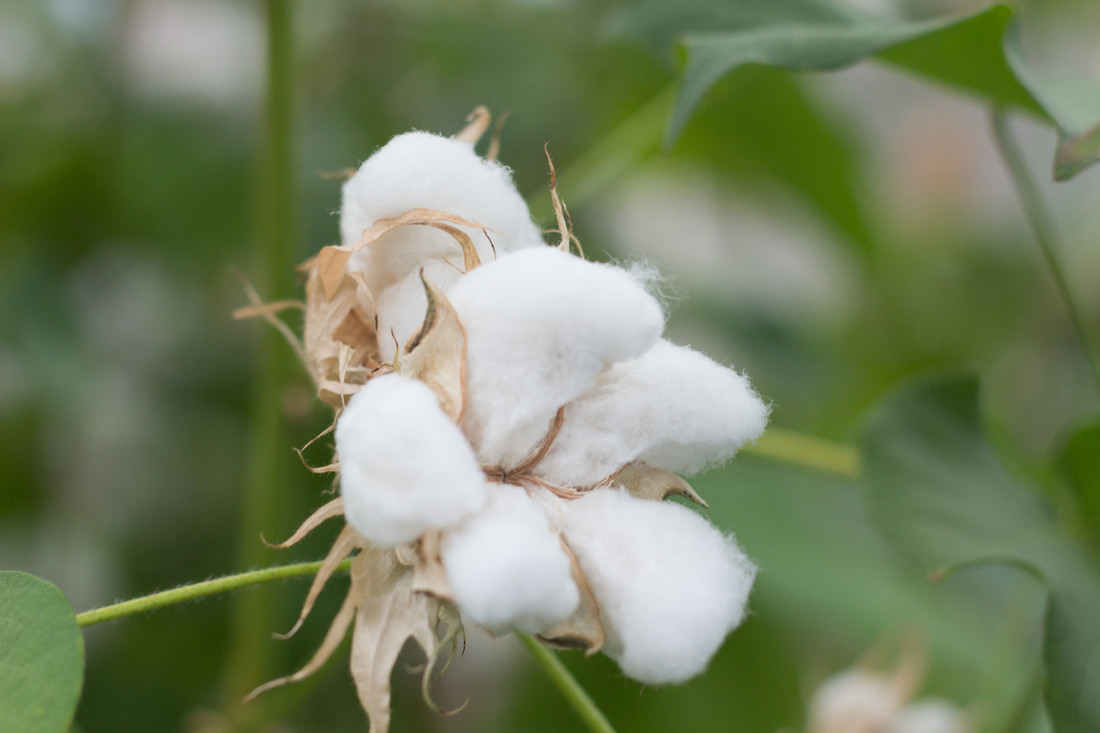
The prestigious Cotton Seed Distributors sponsored award of Cotton Researcher of the Year for 2021 was awarded to CSIRO’s Dr Iain Wilson at a recent Crop Consultants meeting in Narrabri. Iain’s award citation from the judges noted “Iain’s pivotal role in the advancement of germplasm with enhanced Verticillium Wilt resistance through the development of molecular tools employed by the CSIRO cotton breeding program”.
CEO of Cotton Australia Adam Kay said, “Iain’s work will have a real and measurable impact on farmers through his work on disease resistance which will in turn improve yields and reduce the use of chemicals so that’s a win for the economy and the environment.”
Iain noted with his usual modesty: “It’s been a team effort, working to solve interesting but important problems and there’s nothing better in science.” CSIRO at its best, congratulations Iain!
2 June 2022: Cotton research running hot off the press
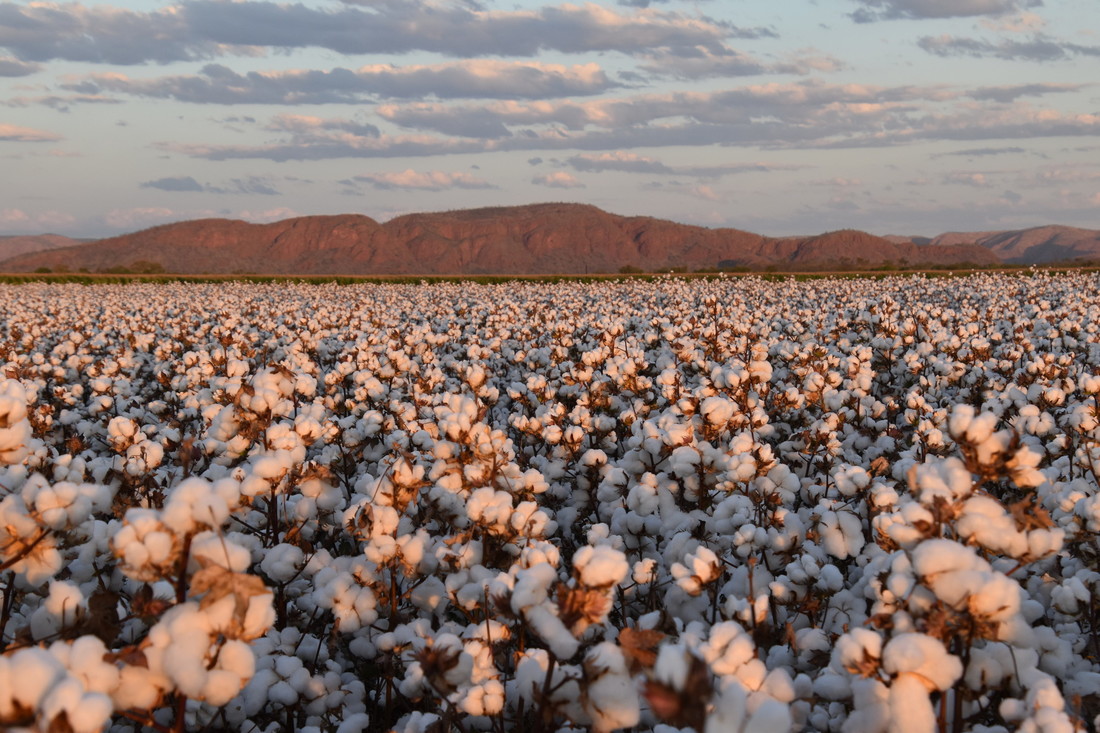
Our cotton breeding and biotechnology team members in Narrabri and Canberra respectively have been busy getting a cluster of publications out. These papers include reviews and opinion pieces on the foundations and future of cotton breeding as well as new research results that show how genomic prediction technologies could take cotton breeding to the next level.
Genomic prediction of cotton fibre quality and yield traits using Bayesian regression methods. Published online 6 May 2022 in Heredity [PDF · 1.4MB].
Cotton Breeding in Australia: Meeting the Challenges of the 21st Century. Published online 13 May 2022 in Frontiers in Plant Science.
Core Collections: Is There Any Value for Cotton Breeding? Published online 28 April 2022 in Frontiers in Plant Science.
Synthetic biology and opportunities within agricultural crops. Published online on 16 May 2022 in the Journal of Sustainable Agriculture and Environment.
23 May 2022: New Omega-3 Canola products Aquaterra® for aquafeed and Nutriterra® for human nutrition

Omega-3 canola was developed in a partnership between CSIRO, the GRDC and Nuseed. Great progress has been reported by Nuseed, initially from North America, in the development of commercial oil products for aquafeed (Aquaterra®) and as a nutritional supplement for human health (Nutriterra®) So far, all safety, stewardship and regulatory steps have been passed and market outcomes are beginning to be realised. The latest information is available on the Nuseed website.
20 April 2022: Using structural biology to understand and engineer plant immunity

Insight into how plant pathogens cause disease and how plants recognise and respond to these pathogens is being investigated from a structural biology perspective in a collaboration between CSIRO and Australian National University researchers. In a recent discussion paper in Current Opinion in Plant Biology the researchers reviewed the recent advances in the field and highlighted future opportunities and directions for engineering designer resistance proteins to provide more durable disease resistance in crops.
12 April 2022: CSIRO’s High Amylose Wheats proving their worth

Two recent publications discuss and substantiate the beneficial gut health properties of food products from the high amylose wheats initially developed at CSIRO in partnership with GRDC and Groupe Limagrain. These wheats are now commercialised globally via Arista Cereal Technologies with Australian Grain Technologies licensed to breed varieties for the Australian market. CSIRO Health and Biosecurity scientists Damien Belobradjic and Tony Bird feature as co-authors in these respective papers in Frontiers in Public Health and The Journal of Nutrition. More information on future delivery in Australian Grain Technologies.
6 April 2022: Tackling an intractable pathogen in chickpeas

The devastating sclerotinia rot pathogen has a wide host range including important pulses and oilseeds and host resistance is difficult to identify and develop further in crop breeding programs. A collaborative publication in Functional Plant Biology involving CSIRO, Curtin University and the University of Adelaide, partly supported by the GRDC, reports on a genetic analysis of quantitative resistance in chickpeas and the location of genomic resistance loci for breeding applications.
28 March 2022: Keeping wheat upright

Lodging in wheat can have a substantial impact on final grain yield.
In a recent publication in Theoretical and Applied Genetics [PDF · 3.6MB] a GRDC-funded collaboration involving CSIRO, Agriculture Victoria Research and Queensland Department of Agriculture and Fisheries reports on low-lodging high-yielding wheat germplasm and the tagging of novel alleles for lodging.
25 March 2022: 60 years of CSIRO's research celebrated by Australian Journal of Grape and Wine Research

A compendium of 11 research articles from CSIRO researchers comprises a 2022 special issue of the Australian Journal of Grape and Wine Research to celebrate 60 years of CSIRO’s engagement with the nation’s grape and wine industries. CSIRO’s research, usually in partnership with Wine Australia and a range of collaborators, has resulted in many new grapevine varieties, rootstocks and farming practices, all underpinned by science excellence. Read the Forward to the special issue authored by CSIRO's Paul Boss and Michiel van Lookeren Campagne.
15 March 2022: New Soybean variety Gwydir released

The soybean breeding collaboration of CSIRO, NSW DPI and GRDC has led to the recent commercial release of the new high protein soybean variety Gwydir that is well adapted to the Northern NSW production regions. Grain from Gwydir is suited for the human food and crushing markets.
Soybeans and other pulses form an important part of CSIRO’s Future Protein strategy to meet the projected growing global demand for diverse protein supplies. Gwydir is being commercialised by Soy Australia.
11 March 2022: Future-proofing wheat for climate change

Long coleoptile wheats, that can be sown into deep moist soil layers, show tremendous promise for yield improvement in the hotter dry conditions expected in future climates. In a recent paper in Nature Climate Change CSIRO teams in crop breeding and farming systems have worked together and put a dollar value on the potential future benefits of the long coleoptile trait. They estimate that wheat varieties with longer coleoptiles would increase farmers’ profits by a staggering average of $2.3-2.4b/year total annually across Australia. More information in an associated CSIRO ECOS article.
11 March 2022: Fishing for introgressed chromosomes in complex polyploid genomes

A new paper in Theoretical and Applied Genetics [PDF · 1.4MB] from scientists of CSIRO, Sugar Research Australia and the USA Hudson Alpha Institute for Biotechnology demonstrates a novel method to isolate an individual chromosome from a highly complex genome for sequencing analysis. They isolate and sequenced an Erianthus chromosome from an inter-generic introgression hybrid with sugarcane which has >100 chromosomes. The Erianthus chromosome carries many candidate genes for stress tolerance.
12 October 2021: Awn-less dual-purpose wheat varieties reduce frost risk for growers

Two new wheat varieties were recently released for 2022 planting by Longreach Plant Breeders that were derived from wheat lines selected at CSIRO. The new wheat varieties LPB Dale and LPB Dual can produce milling quality grain but because they are awn-less they can safely be used for animal feed if grain production has been compromised by frost. Variety details are available at the Longreach Plant Breeders website and further background information is in a media article by Grain Central.
Iain Wilson: a personal impact culture story
This month in our series ‘In Their Own Words: Researcher Stories’, we spoke with Dr Iain Wilson, Principal Research Scientist in the Molecular Breeding Team. Iain was recently recognised for his 25 years of service with CSIRO and he reflected on his journey thus far.
How did you begin your career with CSIRO?
I was recruited by Liz Dennis and Jim Peacock to what was then CSIRO Plant Industry, from the Carnegie Institution of Washington (Stanford) at the end of 1999. Microarrays, a cutting-edge technology at the time to analyse large-scale gene expression patterns, were developed at Stanford in Pat Brown’s laboratory, and I was one of the first to apply microarrays to plant research using Arabidopsis as a model system.
At CSIRO, I set up one of the first functioning microarray facilities in Australia. The focus at the time was on fundamental research mostly in model species such as Arabidopsis, with the goal of expanding knowledge on a wide variety of areas, with the impact mostly measured by the publication quality and number. The then large-scale nature of the data generated ‘new’ problems associated with the analysis and storing data. I identified this challenge and was involved in the hiring of Plant Industry’s first bioinformatician Gavin Kennedy (later replaced by Jen Taylor) and the development of partnerships with CSIRO Mathematical and Information Sciences that led to more rigorous ways of analysing complex datasets.
The development of these collaborations was significant as in the dim dark ages partnerships between CSIRO Divisions were difficult due to funding disincentives. It was only through the good will of very clever and inquisitive scientists in that division that made it work.
You have had a strong emphasis on impact throughout your career. When did you realise that science needs to embed impact?
In 2002, with sponsorship by Graingene (an alliance between CSIRO and Syngenta) the microarray work shifted from Arabidopsis to producing a large-scale array for wheat. This array, containing over 36,000 clones over three separate slides, was applied to characterise alternative wheat dwarfing genes and carbohydrate mobilisation in wheat. However, due to its use being restricted to only Graingene projects, this work failed to make a major impact in wheat research in Plant Industry.
In 2005, my work shifted to cotton with funding from Cottech - an alliance between CSIRO, Cotton Seed Distributors (CSD) and the Cotton Research and Development Corporation (CRDC). The aim was to study waterlogging tolerance, first in Arabidopsis, and then applying the findings to cotton via a transgenic approach by overexpressing key anaerobic response genes.
This work really epitomised the period where it was thought that there were simple genetic modification solutions to complex problems, largely based on the success of Bt cotton in combating the insect problem that almost ended the cotton industry in Australia.
In hindsight this period of work was more about continuing previously successful research from model systems into a crop - its foundation wasn’t necessarily based in solving the problems that were considered important in the cotton industry. However, it’s also fair to say that the impact of the work also wasn’t helped by the upcoming millennial drought.
How did your relationship with the cotton breeding program begin?
In 2008 it was made abundantly clear to me by Frank Gubler and Danny Lewellyn that that era of model system research was ending, and the time for choosing a real crop was nigh. As I had experience with cotton, I was given the opportunity to lead a small group who worked on cotton disease resistance.
Before my arrival, the work was mostly focused on repeating the type of research carried out in model systems. However, I knew from previous work in Arabidopsis that cotton was not, and never would be, a model system and the only value of this research was in aiding the CSIRO cotton breeders to deliver more resistant varieties.
The breeders were initially distrustful of my interest as ‘molly bollies’ such as myself had promised so much but delivered so very little impact. The relationship took many years to develop, and it took many small wins and a focus on practical solutions rather than just publications.
You and your team have been long-term quiet achievers in the Australian cotton industry and often work in the background out of the spotlight. However, your research has had a huge impact on the industry. Tell us a bit more about what you have achieved.
Amongst various other outcomes, our work has been most widely recognised in the biotic resistance area. This has been observed in cotton varieties released with significantly improved Fusarium and Verticillium wilt resistances. In addition, the most recent varieties released and all future varieties in the development pipeline, contain resistance to the virus resulting in the disease Cotton Bunchy Top. My work has been pivotal in the identification of accurate molecular markers for Black Root Rot (BRR) resistance, enabling the development of germplasm with excellent resistance to BRR. The future impact of this work (variety release is expected in 6-8 years), particularly the Southern and cooler growing regions, will be significant. Recently the gene for Spider mite resistance was identified by Dr Qian-Hao Zhu, that turns out to be a susceptibility gene that when knocked out increase’s resistance. This provides an opportunity both to breed for resistance and or create resistant germplasm through mutation and gene editing. My research and research team has and continues to significantly improve the overall sustainability of the cotton industry, particularly from a disease management standpoint. My research achievements have greatly benefitted from the long-term funding relationship with Cotton Seed Distributors Ltd., who understand the long timelines involved.
I have come to appreciate the great work of breeders, the true phenomics profession, that is now embracing a panomics approach in order to accelerate genetic gain. I believe the partnership between my molecular group and the breeders really flourished when our goals were aligned: to release commercial varieties with improved resistance, but with elite yield and fibre quality.
In 2022, you were awarded the Australian Cotton Industry’s Research of the Year Award. Congratulations!
The award was a great honour, as it is an industry award that is rarely awarded to those working in the ‘ivory towers’ of Canberra. Although the work is not finished, the award indicates that my team is on the right path to delivering impact to the Australian cotton industry.
Finally, how would you sum up your key learnings?
Through the sometimes not so subtle teaching of Warwick Stiller and others, I have come to appreciate that disease resistance, although complex in itself, is just one trait among many. It is important but does not stand alone as it’s the complete package that is important. A simple but important point for all to realise is that your research fits into a larger world and must be compatible with it to have impact.
Thanks Iain and we look forward to seeing your future progress and success.
Iain Wilson’s career is a shining example of how CSIRO’s role in the innovation system is to create impact for our customers and more broadly Australia. It also highlights how a personal impact mindset journey can lead to both success in science and industry impact.
Soft launch of Bollgard 3 XtendFlex (B3XF) Cotton varieties at Australian Cotton Conference 2024
The 2024 Australian Cotton Conference, held on Gold Coast between 6-8 August, was the largest gathering of cotton researchers and scientists, farmers and agronomists, marketers, industry organisations, spinners, brands and retailers in the event history.
One highlight was the soft launch of the Bollgard 3 XtendFlex (B3XF) Cotton varieties. These were bred by the CSIRO cotton breeding program and developed in collaboration with Cotton Seed Distributors and Bayer Crop Science. The B3XF varieties have tolerance to over-the-top applications of registered glyphosate, dicamba and glufosinate-ammonium herbicides, providing growers with new flexibility to manage a wider-spectrum of difficult-to-control and resistant weeds in-crop.
Other CSIRO research presented included AI and disease resistance research. If you missed the opportunity to attend, you can view the recorded presentations online.
Shortage of plant breeders threatens food security
Success in maintaining international food security could be in question with a new study which quantified the lack of plant breeders being trained across the important food exporting countries Australia, New Zealand, and Canada, painting a grim picture for the near future unless some action is taken.
Plant breeding is a multidisciplinary science that underpins the agricultural sector and therefore global production of food, animal feed, fuel, and fibre.
The study showed that a large proportion of highly-skilled plant breeders are now reaching retirement age, and there is a generational gap for succession planning as university graduates opted to focus on other areas of plant science including molecular biology.
However, long-term solutions were proposed which included the establishment of dedicated training facilities in different countries, co-ordinated approaches between the public and private sectors, and increased promotion of the plant breeding sector.
The research was a collaboration between CSIRO, Lincoln University in New Zealand, and McGill University in Canada.
2 October 2024: Enhancing Fusarium crown rot resistance
For over four decades, Fusarium crown rot has been a persistent issue for wheat and barley growers. Growing resistant varieties is one approach in managing the disease.
Dr. Zhi Zheng and his team works to develop genetic solutions to enhance resistance.
“We’re trying to improve the Australian germplasms without interfering with crop performance,” Zhi said.
Supported by investment from the Grains Research and Development Corporation (GRDC), the team has identified five loci that confer resistance to crown rot. Among these, two novel loci for Australian wheats stand out: Fhb7 and another on the 3B chromosome.
The team introduced the Fhb7 gene into Australian wheat varieties and crossed it with existing loci, creating pre-breeding lines and markers for breeding companies. As the project enters its final year, paired plot field trials are underway at research stations in Narrabri (NSW), Boorowa (NSW), and Forest Hill (Queensland). These trials compare yield loss between inoculated and non-inoculated plots to assess the effectiveness of the resistant gene.
Preliminary results from 2023 single row field trials are promising. Backcrossed lines with the Fhb7 gene have shown significantly higher grain yields in the presence of crown rot. The largest yield difference was observed at Narrabri with 11.4%, followed by Forest Hill with 8.7%, and Boorowa with 7.2%.
Zhi believes additional sources of resistance are needed to further improve Australian wheat and barley.
“This will provide breeders with a broader pool of resistance and tolerance, ensuring better crop performance and sustainability.”
13 August 2024: Farmers in Ghana get access to CSIRO-developed borer-resistant cowpeas
Cowpeas are a key protein source in Sub-Saharan West Africa, but their yields have been reduced by pod borer insects, which required pesticide use.
In collaboration with African and international research agencies, we developed pod-borer resistant cowpeas. Nigerian scientists further improved these cowpeas, which are now approved and grown by Nigerian farmers.
Recently, Ghana also approved these insect-resistant cowpeas, marking the first genetically modified crop in the country. This will help improve food security and reduce pesticide use in Ghana.
Read more about this news from the International Service for the Acquisition of Agri-biotech Applications and the Ghana News Agency.
19 July 2024: New dried grape variety Murray Bold attracting grower attention
We have bred and released many new grapevine varieties for diverse product applications including dried grapes, wine grapes and table grapes.
This year there is considerable interest developing, particularly in Sunraysia growers, for the newly released dried grape scion variety Murray Bold we developed.
The new Murray Bold variety was released under Plant Breeders Rights protection in 2023, and formally launched at the Secur Family Farm’s Merbein South Vineyard in 2024
Initial trials have shown the new variety to be high yielding . Most importantly it is rain resistant with non-splitting characteristics. Early ripening provides another option for managing risks of drying berries late in the season when conditions may be less favourable.
There is optimism that Murray Bold may offer an attractive alternative to established sultana varieties such as SunMuscat, a well-established dried grape variety also introduced by CSIRO to the Australian industry many years ago.
Growers are now able to access and evaluate Murray Bold under their own farm conditions and hopefully it will prove its worth for the industry overall. Read more in the North West Farmer.
18 June 2024: Sowing the seeds of rust resistance
Our Plant Pests and Diseases team have embarked upon a five-year, $10 million research program with The Sainsbury Laboratory, a subsidiary the Gatsby Foundation (UK), to bring rust resistance wheat to market.
This builds upon the success of previous work undertaken with the 2Blades Foundation, which used gene-stacking technology to deliver durable resistance to wheat stem rust disease.
This next phase focuses on creating genetically modified (GM) wheat lines that are ready for commercial release and deregulation. An important focus is overcoming international regulatory barriers for genetically modified wheat varieties.
Recent reviews of the regulatory environment suggest genetic modification using genes within the plant’s natural gene pool (also know as cis-genics) reduce the risk associated with commercialisation of GM wheat products.
Not only does the team hope to develop technology for multi-gene stacking for durable resistance in wheat, they also hope the research will extend to provide solutions to disease in many other economically important crops, like canola, soybean and maize.
7 May 2024: GPA-Nufarm ‘Paddock to Parliament’ Scholarship
Grain Producers Australia (GPA) and Nufarm have teamed up to launch an exciting initiative aimed at cultivating the next generation of leaders within the Australian grains sector. Crop scientist, Dr Jess Hyles, took the opportunity to explore new horizons enabled by a Paddock to Parliament Grains Advocacy Scholarship.
Jess has impressive balancing skill. She juggles a successful career as a research scientist with co-running a farm business in the NSW Southern tablelands alongside her husband and nurturing their family. It's no wonder that she eagerly accepted the personal growth challenges and prospects the GPA-Nufarm scholarship brought her way.
Jess took an active role in shaping a project that led her to travel to capital cities and regional hubs throughout Australia. She attended various industry events and meetings, forging connections with the innovative minds and entrepreneurs among the growers, as well as with industry advocates, crop breeders, investors, market specialists, and traders.
"I thrive on stepping out of my comfort zone and embracing new experiences,” said Jess
“It's been incredibly rewarding to immerse myself in a cause I'm passionate about and to bolster my confidence beyond my usual work environment."
Her journey culminated in a quintessential paddock-to-parliament moment when she joined the GPA Policy Council members at a special event in Parliament House.
For a deeper dive into this scholarship program and to follow Jess's ongoing journey and insights, visit the GPA website and read: Jess gets the Paddock to Parliament experience with scholarship.
28 March 2024: Academy recognises our early career researchers
Congratulations to Dr Ricky Milne and Dr Megan Outram from our Pest and Disease Group who were recently awarded prestigious Thomas Davies Research Grant for Marine, Soil and Plant Biology grants for 2024.
The Australian Academy of Science oversees awards early career researchers (ECRs) these research grants from a generous philanthropic bequest from the estate of the late Thomas Lewis Davies.
Ricky and Megan will use the funding to to boost their research efforts in generating new disease resistant crop plants.
Ricky is working on expanding the utility of a wheat gene that provides broad spectrum resistance to fungal pathogens
Megan is working to combat rust fungi that cause disease in crop plants by using a data-driven structural biology approach to customise 'resistance genes' to act of wide range of fungal variants.
These awards will contribute to our effort to provide a strong biosecurity foundation underpinning protection for Australian agriculture from evolving endemic and exotic disease threats.
22 March: Food Futures Symposium Advances Sustainable and Nutritious Food Production
On March 22, the Australian Academy of Science (AAS) hosted the Food Futures: Nourishing a Nation Symposium as part of Brisbane’s successful World Science Festival celebrations.
The symposium focused on the sustainability challenges facing Australia’s food systems, both domestically and in export markets.
Key topics discussed included:
- Climate change: The impact of adaptation and mitigation responses to climate change
- Supply chains: The fragility of supply chains
- Consumer choices: Shifts in consumer preferences related to diet, nutrition, and product affordability
The symposium featured five of our scientists, highlighting their national leadership role in developing science for the future of the national food system. These included John Kirkegaard and Greg Rebetzke (Crop Scientists), Di Mayberry (Livestock Systems Scientist), Gilly Hendrie (Public Health and Nutrition Scientist), and Rohan Nelson (Director of CSIRO’s Food Systems Horizons partnership with The University of Queensland).
These speakers meshed with a wide range of agriculture, food, nutrition and policy specialists from around the country. Each emphasised the importance of collaboration and interdisciplinary approaches to enhance the resilience of our food system.
Despite the challenges ahead, it’s encouraging that the AAS recognizes the critical role of ongoing excellent and impactful science in supporting sustainable and nutritious food production. This benefits not only the Australian community and environment but also the broader region and planet.
21 March 2024: Cultivating global perspectives through Nuffield Fellowship
2023 was a big year for Dr Vivien Rolland. He was recognised as the ACT Young Tall Poppy Scientist of the Year and was also the successful recipient of a Nuffield Australia Fellowship.
The Nuffield Fellowships provide a unique opportunity to travel domestically and internationally with other Fellows to learn more about global practices in farming and food production. It also provides an opportunity to grow personal and career perspectives to help improve local and global agrifood industries.
Now back and refreshed, Viv is keen to share with us some of his experiences and key learnings from his Nuffield Fellowship.
What attracted you to apply for the Nuffield Fellowship opportunity at this stage of your life and career?
The sense of purpose. We use our science to deliver innovation to the agrifood sector, and ultimately to the people who produce our food and fibre.
Nuffield was the perfect vehicle to better connect with people on the ground, in Australia and globally. To get exposed to, and learn from, a range of sectors and individual perspectives that no other development opportunity in Australia can provide at this scale.
Where did you go?
I did two five-week trips. The first one trip was to Canada and New-Zealand. I attended the 2023 Contemporary Scholar Conference in Vancouver, where all 85 new Nuffield scholars from 15 nations got together to connect, explore and discuss many facets of global agriculture. I then went to New-Zealand for the 2023 Nuffield Triennial Conference, where several hundred Nuffield scholars from all nations and past years get together. Both events included lots of farm visits. These were amazing opportunities to explore completely different facets of topics covered in talks.
The second trip was the Global Focus Program (GFP) which, as 2017 Nuffield Australia Scholar Stuart Tait describes, was ‘a whirlwind tour of global agriculture from top to bottom and left to right’.
My GFP took me through the bush of Zimbabwe, the post-Brexit pastures of England, the dry south of Spain, the gorgeous North of Italy, to finish at the Food and Agriculture Organisation (FAO) in Rome. There I was immersed in all-encompassing discussions at both the World Food Forum and the UN Committee on World Food Security.
Tell us a bit about the other Nuffield Fellow team members that accompanied you on your travels
On my GFP, there were 10 of us in total. In addition to me, there were four Australians with interests in viticulture and climate change, value adding in mixed farming, leadership coaching in rural communities, and rangeland regeneration.
Other colleagues included a Canadian rancher and a Japanese dairy farmer both looking at selling products directly to consumers. An Ag-consulting company CEO from New Zealand interested in how Ag consultants will evolve in the future. And and a Brazilian coffee farmer exploring opportunities for a carbon market for perennial crops.
I must say that when you talk about growing coffee or making gelato with your own milk and strawberries, everyone is very welcoming!
Looking back, what were the most memorable places and events you experienced?
That is a hard one. Everything was amazing in one way or another, and there were learnings to unravel everywhere.
In Zimbabwe, what was powerful was the resilience of the people we met, producing products in a challenging political, economical and historical context.
In England, it was particularly interesting to see how large historical estates are modernising by focusing on engaging and supporting community or by divesting from farming and regenerating the environment.
In Spain, it was fascinating to immerse yourself in a range of very traditional production systems linked to local cultural heritage (e.g. fighting bulls, olive oil, wild goose foie gras).
And in Italy it was interesting to reflect on the importance of Terroir (essentially the growing conditions of a location) and Controlled Designation of Origin (DOC) to produce food in specific regions (e.g. Prosciutto, Parmegiano-Regiano).
Provenance harnesses the power of stories and micro-regional identities built over centuries but it is now challenged by climate change which introduces new constraints in geographically-restricted production systems.
OK, the Fellowship is meant to be a learning and development experience, so what were the standout lessons for you and how has it shaped you as a person and a scientist?
That is a big question. There were fundamentally three types of learnings: technical, cultural and those about people. And agriculture is built off the back of these three facets, so it makes sense.
The technical learnings are too many to detail here and are partly covered by my previous answer.
The cultural learnings were unbelievable – I met hundreds of people in six vastly different countries, and the beauty of Nuffield is that it opens doors you would never be able to open on your own. Plus, in each country you are hosted by locals who share their kindness, passion, humanity, and some of their culture too. But the thing that stretched most people was that you are literally stuck with the same ten people 24/7 for five weeks at high pace.
You are always on the move, meeting amazing people and each minute of the day requires your full attention and engagement. It is not always easy but you learn a lot about yourself, how you interact with and care for others, and how you resolve conflicts and maintain a great team culture.
It’s also meant to be a fun experience – do you have an amusing anecdote from the trip?
It certainly was not when we got pulled over by Police three days in a row in Zimbabwe… It would have to be a couple of days later when we got chased by an ostrich!
Finally, what will you do differently in 2024 and beyond?
They say Nuffield turns your life on its head! But it’s probably too early to tell.
It is clear that Nuffield has broadened and deepened my appreciation for the real problems faced by food and fibre producers in industries and countries beyond those I am involved in.
It has strengthened my focus on impact and shifted my thinking towards a more holistic level.
Exploring and engaging with so many of the building blocks of the Agrifood world has helped me better understand how they interlock and has brought to the fore the idea that each coin comes with two inseparable sides which are part of the same story.
We need to listen, understand, and work together to build local solutions to global problems.
Thanks Viv and we look forward to seeing your future progress and success.
22 February 2024: Self-fertilising crops expertise featured in New Yorker.
A recent article featured the New Yorker, titled: Will Plants Ever Fertilize Themselves? highlighted our work on engineering a novel nitrogenase enzyme that could enable crop plants to directly obtain nitrogen from the atmosphere.
This longstanding scientific challenge could revolutionize agriculture by allowing crops to grow without traditional nitrogen fertilisers. This novel approach could significantly reduce fertiliser costs for farmers and cut down greenhouse gas emissions associated with fertilizer production, transport, and use.
The article named new approaches aimed at engineering bacterial nitrogen-fixing nitrogenase enzymes to function in plants. Synthetic biologist Craig Wood, who leads our nitrogenase engineering team, featured in the story and gave an insight into the team's progress and pathway forward. He outlined our focus on engineering a novel iron-dependent nitrogenase that is targeted to plant mitochondria.
The attention from The New Yorker meant our research reached over a million readers worldwide and shows that our pursuit of sustainable farming is gaining global attention.
For those interested in a deeper dive, read Nitrogen for nothing and your protein for free which provides more information on our work.
29 January 2024: High-amylose wheat growing fast in Australia
A key component of a healthy diet is adequate fibre intake. Several years ago a research partnership of CSIRO, GRDC and Groupe Limagrain developed the novel high-amylose trait in wheat, resulting in grain with dietary fibre content up to ten times higher than that of conventional wheat grain. The trait has been commercialised via Arista Cereal Technologies, and in Australia a supply chain for high amylose wheat has been established with the cereal breeding company Australian Grain Technologies (AGT) and the milling company Pinnacle which also has export arrangements for the product with its Japanese parent company, the Nisshin Seifun Group.
Results for the second year of commercial production in Australia from AGT's first variety HAW1 are now being reported as approximately 9,000 tonnes, almost triple that of last year. The number of growers producing HAW1 has grown from 11 to 17 and production has now expanded from Victoria to also include South Australia. Growers are receiving a price premium for growing HAW1 and appropriate arrangements have been put in place to ensure grain segregation so that market requirements for such specialised grain are met. Further expansion is predicted for the future and new high-amylose wheat varieties are in the pipeline at AGT to provide better adaptation and yields.
In the USA high-amylose wheat and flour products is commercialised by Bay State Milling company and is now available in a wide range of food products, suggesting that similar market growth will eventuate for Australian based production. David Mattews is a contracted accumulator for Allied Pinnacle and you can read his comments on the rapid growth of high-amylose wheat in Australia and beyond in this recent article in Grain Central.
19 December 2023: Next decade of winegrape research takes root
CSIRO's grapevine breeding team are continuing work with Wine Australia to answer some of the Australian wine industry's most pressing concerns.
In a continuation of a relationship that started over 30 years ago, our researchers are looking to utilise cutting-edge breeding technologies to develop outcomes such as gene-edited clones from established varieties, new varieties with unique quality and agronomic characteristics, and rootstocks that provide improved adaptation to Australian conditions.
The research agenda is the result of wide consultation with the domestic wine industry across the value chain. This has led to the development of a research vision, co-designed with industry, to inform the next decade of research. For more information on our work with Wine Australia visit their website.
4 December 2023: Award winning Legume Engineering Team
Success in developing Future Crops at CSIRO Agriculture and Food was recognised at the recent CSIRO 2023 Awards Ceremony with the Legume Engineering Team winning the prestigious Chair’s Medal for Science and Engineering Excellence. A big congratulations to the team members, TJ Higgins, Lisa Molvig, Andy Moore, Jose Barrero Sanchez, Luch Hac, Jenny Gibson and Javier Atayde. Cowpeas are a vital protein-rich food crop in West Africa and the team were responsible for developing pod borer resistant cowpea varieties now available to farmers in Nigeria and Ghana.
This novel technology brings food security and income for smallholder farmers and greatly increases yields while reducing the need for the use of potentially dangerous insecticides. Development and delivery of the insect resistant cowpeas developed at CSIRO was facilitated by an international collaboration involving African scientists, regulators and industry bodies as well as funding and technology inputs from agricultural institutions in the USA. Further information on the development and delivery of the insect-protected cowpeas can be found here.
28 November 2023: Next-gen talent for Future Crops
To continue to apply excellent science to Australia’s biggest challenges it is vital that CSIRO continues to attract the best international science talent to its laboratories and projects. In particular, top quality early career researchers such as postdoctoral fellows bring new ideas and energy to CSIRO’s projects. Dr Nick Fradgley completed his PhD at the University of Cambridge in the UK in 2022 in a joint industry-focused project with supervisors from the UK’s National Institute for Agricultural Botany (NIAB) and the cereal breeding company DSV UK. After an internship at the International Maize and Wheat Improvement Center (CIMMYT), Nick joined CSIRO earlier this year as a CERC Postdoctoral Fellow working in CSIRO Agriculture and Food.
Excitingly, in November 2023, The Genetics Society of the UK announced that Dr Nick Fradgley was the winner of the 2023/24 Sir Kenneth Mather Memorial Prize. This prize is awarded to a graduate showing outstanding merit in pure and applied aspects of biometric or population genetics. Nick’s thesis title was ‘Genetic control and prediction of milling and baking quality for UK wheat breeding’ and he explored applying quantitative genetics tools and models in a commercial wheat breeding programme to improve the prediction and selection of wheat milling and baking quality for future climates.
Now at CSIRO, Nick is working with a team led by Dr Jess Hyles to model genotype by environment interactions in long-term wheat multi-environment trial datasets to understand and predict adaption, and design future crops for Australian growing environments.
Nick is a fine example of the exceptional science talent that is recruited into CSIRO’s research projects, bringing highly credentialled science skills and industry knowledge to current research challenges that are focused on the Australian grains industry. You can read more about Nick’s award on The Genetics Society award webpage. Congratulations Nick!
23 October 2023: Homage for Flor’s ‘gene for gene’ model for disease resistance
The gene-for-gene model that genetically explains plant-pathogen interactions was proposed by American scientist Harold Henry Flor based on his life's work with the rust fungus (Melampsora lini) of flax (Linum usitatissimum). Flor's model proposed that the inheritance of both resistance in the host, and virulence in the pathogen, is controlled by pairs of matching genes. This model has since been exemplified in many plant disease systems. To commemorate Flor's foundational contribution to plant pathology the field’s leading journal, Molecular Plant Microbe Interactions (MPMI), has established the H.H. Flor Distinguished Review where world leading scientists are invited to contribute. This year, CSIRO scientist Peter Dodds was asked to provide his personal perspective on the importance and impact of Flor’s work.
This is poignant for CSIRO because Flor's flax rust system was further developed by our scientists and led to the cloning of the flax L6 resistance gene, published in 1995. This was one of the first of a cohort of plant resistance genes cloned, in what was then a very competitive scientific race to explain Flor's model at the molecular level. Subsequently, multiple disease resistance genes in other plants, including Australia’s major crop wheat, have been cloned by CSIRO scientists and our collaborators.
The matching pathogen avirulence genes have also been identified and his has led to a highly refined molecular model at the protein structure level that explains how pathogens are recognised and resistance activated. These advances have opened new approaches to manipulate disease resistance in future crops.
9 October 2023: Peer recognition for cotton scientists
The Association of Australian Cotton Scientists (AACS) is an industry-supported association focused on maintaining scientific excellence underpinning impact and benefits for Australian cotton producers. The AACS 2023 meeting was held in Toowoomba in September and several awards were received by CSIRO scientists.
Dr Lucy Egan received the Early Career Scientist Encouragement Award for her work on developing disease resistant cotton germplasm as a member of the CSIRO cotton breeding program based at Narrabri. The AACS Scientific Publication Award was received by a Narrabri-based CSIRO research team together with co-authors from The University of Newcastle and NSW Department of Primary Industries for their paper entitled ‘Soil compaction in a new light: Know the cost of doing nothing – A cotton case study’.
Finally, Finally, Drs Lewis Wilson, Danny Llewellyn, Liz Dennis and Mary Whitehouse were awarded Lifetime Membership of AACS for their scientific contributions to the cotton industry. Congratulations to all and further information on AACS can be found on their website.
12 September 2023: Award-winning super-high oleic safflower oil
Super-high oleic (SHO) safflower oil is a novel plant oil developed in a research and innovation partnership between CSIRO and the Grains Research and Development Corporation. Plant gene silencing technology, developed at CSIRO, was used to modify the oil biosynthetic pathway of safflower so that its seeds produce oil with high levels (92-93 per cent) of oleic acid which provides high stability for applications in both the food and oleochemical industries.
A scientific publication from the CSIRO team describing this breakthrough can be viewed in a 2018 paper in The Plant Biotechnology Journal. SHO safflower oil is being commercialised by the Australian agricultural technology company GO Resources and oil for culinary purposes has been developed and marketed by the Australian company Plenty Foods and can now be found on some supermarket shelves. Recently, because of its novel health characteristics SHO safflower oil was announced as the winner of the best oil category amongst the 2023 awards of Healthy Foods Guide Magazine. More information on the award and the benefits of SHO safflower oil can be found on the Plenty Foods website [PDF · 4.2MB].
22 August 2023: Cool science to enhance chickpea production
Increased production of chickpeas and other pulses will be important as a part of Australia’s contribution to meeting the predicted growing global demand for protein as described in Australia’s Protein Roadmap released last year. Growing chickpeas in regions, such as South-West Australia, that have a Mediterranean type of climate, would benefit from plant types that have greater reproductive chilling tolerance.
To this end, a team of CSIRO crop scientists based in Perth, with support from the Grains Research and Development Corporation (GRDC), have studied the role of vernalisation (chilling that induces flowering) in the phenology, growth and partitioning in domesticated chickpea and wild representatives of the chickpea genus Cicer in contrasting temperature regimes. While the wild material has more cold tolerance than domestic chickpea, both types can perform well under low temperature stress if they receive an early exposure to cold temperatures, regardless of their inherent vernalisation response. This is important because it demonstrates how the early sowing climate influences subsequent responses of chickpeas to cold. It also suggests that it will not be necessary to introduce a vernalisation response to chickpea when bringing in the cold tolerance from the wild.
This is good news because chickpea breeders are understandably reluctant to introduce vernalisation traits which are potentially undesirable for many Australian production environments. The team’s results have been published in Field Crops Research.
13 July 2023: Omega-3 canola oil aquafeed approved by Norway
Canola that produces Omega-3 oil was developed in a partnership between CSIRO, NuSeed and the GRDC and is being commercialised for aquafeed by NuSeed under the brand Aquaterra®. The plant-based Omega-3 oil Aquaterra® provides a sustainable alternative feed ingredient for fish aquaculture which historically has relied on non-sustainable wild-caught fish as a source of Omega-3 oil aquafeed supplements which are important for fish development and nutrition. Norway is the world’s largest producer of farmed salmon, with total yields of approximately 1.6 million tonnes per annum.
In a recent major advancement, the use of NuSeed’s commercial Omega-3 canola oil aquafeed product Aquaterra® has been approved as safe for use in fish feed applications by the Norwegian Food Safety Authority (NFSA). The use of Omega-3 canola oil in global aquaculture will reduce pressure on wild fish populations and their ecosystems and will be critical in meeting the growing global human nutritional demands in a sustainable way. More information on the NFSA approval is available via the Aquaterra® website.
4 July 2023: Impact from CSIRO-bred cotton in North America
It is well known that CSIRO’s cotton breeding program has produced more than 100 varieties for Australian growers, consistently generating the world’s highest yields. In addition, CSIRO-bred varieties have also had significant impact overseas. The global reach of CSIRO-bred cotton varieties has been boosted as the 2023 cotton planting season in the USA and Mexico marks the first time that CSIRO varieties will be sold under the Deltapine brand, a Bayer CropScience (BCS) company. Deltapine is the largest cotton seed brand in the USA and the new CSIRO-bred variety, DP2335B3XF, will enhance their product portfolio, specifically for West Texas. An additional new CSIRO-bred variety, sold under the Amour brand as 9512B3XF, will also be sold in the USA in 2023. Amour is a brand of the WinField United Group, a major Agribusiness in North America with over 2,800 retail outlets.
The release of these new varieties builds on existing global sales of CSIRO cotton varieties under the FiberMax brand, now sold in six countries outside Australia. International partnerships with multi-national life science companies such as BCS have been critical for securing access to the insect pest resistance and herbicide tolerance traits that are crucial to effective cotton production in Australia. The success of cotton varieties both in Australia as well as globally is the result of both the efforts of its dedicated breeding team members and long-term focused research partnerships with industry, most notably Cotton Seed Distributors (CSD) in the Joint Venture, Cotton Breeding Australia. The release of these two new varieties in North America is acknowledged in CSD’s 2023 Annual Report.
6 June 2023: Salt-tolerant grain crops for Bangladesh
CSIRO science is delivering to help improve the livelihoods of farmers in Bangladesh. Richard James and colleagues at the University of Western Australia, who worked with Professor Willie Erskine, collaborated with scientists and wheat breeders in Bangladesh to develop wheat varieties with improved salt tolerance for southern Bangladesh. This ACIAR-supported project focused on testing wheat lines carrying the CSIRO salt tolerance Nax genes in a targeted wheat breeding program across a range of saline field conditions. A secondary objective was to train Bangladeshi researchers in developing screening protocols, improved field design and salinity characterisation methodologies, and an efficient, field-based framework for assessing and ranking wheat lines for salt tolerance.
The genes and diagnostic molecular markers were bred into a range of Bangladeshi wheat varieties and then comprehensively evaluated in the field over three seasons at nine trial sites varying in salinity. Evaluation of the breeding lines showed the salt tolerance genes reduced the build-up of sodium in the leaves of wheats containing the CSIRO-developed genes. A positive outcome was a 10-20 per cent yield improvement at high-salinity field sites. The Bangladeshi wheat breeders are now using the Nax genes in developing new breeding lines, some already included in advanced trials this year. A scientific publication has been accepted, highlighting some of the key findings from the project.
5 May 2023: Predicting flowering time in wheat
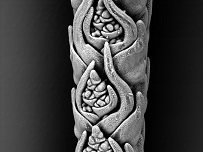
The flowering time of wheat crops in particularly important as seasonal stresses such as frost, low solar radiation, heat, water deficit and disease significantly affect yields if flowering occurs either too early or late. Accurate prediction of flowering time for wheat varieties in specific environments would greatly aid farmers optimise their yields. To this end a collaboration of cereal farming system and genetics scientists from CSIRO, La Trobe University, The New Zealand Institute for Plant & Food Research, Curtin University, The University of Melbourne and Field Applied Research Australia have studied the photoperiod and vernalisation responses of 69 Australian spring and winter wheat genotypes.
Flowering time in wheat is genetically controlled by five phenology genes at the VRN1 and PPDA1 loci and the wheat varieties studies were selected for diversity at these loci. Flowering times in spring genotypes were typically decreased by long photoperiod rather than vernalisation while the opposite was true for winter wheats. Sensitivity to vernalisation in spring wheats was mainly determined by a specific Vrn-A1 allele. The data from this study can now be used to develop a wheat phenology model to assist growers predict flowering time in wheat varieties for their environments. This work has recently been published in CSIRO’s journal Crop and Pasture Science.
27 March 2023: A disease resistance gene of wheat springs a functional surprise
Most disease resistance genes in plants confer protection only against specific strains of pathogens. In wheat, some adult plant rust resistance genes such as the Leaf rust resistance 67 (Lr67) gene have been shown to confer resistance to multiple pathogen species, particularly biotrophs that do not kill host cells during infection. The cloning of the Lr67 gene was reported by scientists at CSIRO and collaborators in 2015 and its predicted protein sequence and structure strongly suggested that it functioned as a sugar transporter. In a recent publication in the journal Plant Physiology, a collaboration of CSIRO and the University of Adelaide and Western Sydney University has revealed a different and surprising function for the Lr67 protein.
Detailed membrane transport studies showed that the Lr67 protein acts a novel anion channel that would potentially perturb ionic equilibrium across membranes in wheat. Exactly how this function might contribute to disease resistance is yet to be determined but ionic fluxes have been implicated in plant immunity functions in other plants. The broad-spectrum adult wheat resistance genes such as Lr67 have proven to be very durable in the field and have so far withstood pathogen evolution to virulence. Understanding the mechanism of action of Lr67 is therefore important for future novel breeding crop protection strategies.
20 February 2023: New world-class facilities for CSIRO’s cotton researchers
In February 2023, brand new upgraded facilities for CSIRO’s cotton research at the Myall Vale site were officially opened.
This $25 million infrastructure improvement will sustain the world leading industry outputs of CSIRO’s research teams in cotton breeding, cotton crop protection and agronomy into the future. Read the media release.
27 January 2023: Synthetic biology produces new dye-free pink cotton fibres
Cotton is a biodegradable fibre renowned to producing textiles that are comfortable to wear or use in homewares. Modern cotton varieties produce white cotton fibres in a boll that following post-harvest ginning and spinning processes needs to be dyed to produce coloured textiles. However, the industrial process of dyeing using synthetic chemicals is potentially harmful to the environment and human health. Thus, it would be very beneficial if post-harvest dyeing could be avoided by generating cotton plants that produce fibres that already have desirable colouring in them.
A few years ago, a project was initiated to do this within the CSIRO Synthetic Biology Future Science Platform and has achieved the first genetically engineered pink cotton fibres. The research was conducted by researchers in the Cotton Biotechnology Group of CSIRO Agriculture and Food based in Canberra and has just been published in a paper entitled 'Pink cotton candy'—A new dye-free cotton in the Plant Biotechnology Journal. In this work, three foreign plant genes that encode proteins of the biosynthetic pathway for the red pigment betalain were introduced into cotton so that they would be expressed in developing fibre cells. The resulting novel cotton plants produced aesthetically pleasing pink fibres demonstrating that the principle of in planta dyeing of cotton fibres is possible.
6 January 2023: Meet Sally Buck: Supercharging the plant-based protein industry
Dr Sally Buck discovered a passion for plant research and is now helping to feed the future.
She never dreamed of becoming a scientist when she grew up. But that was only because she didn't know it was an option. Now she's working on developing nutritious plant-based proteins as part of our Future Protein Mission.
Read more about her work and journey into a career in future crop science on the CSIROscope blog.
15 December 2022: Accolades for Liz Dennis and her team’s hybrid mimics in food crops
Liz Dennis, currently an Honorary Fellow in the Crops program at CSIRO Agriculture and Food, is one of Australia’s best known plant scientists and continues to generate exciting science advances for the future crops impact area. Liz has been awarded the 2022 Ruby Payne-Scott Medal by the Australian Academy of Science that recognises researchers of the highest standing in the physical or biological sciences and is among the most prestigious career awards that the Academy of Science presents. Liz, together with her long term and equally celebrated CSIRO colleague Jim Peacock, have been working on developing better ways to harness the large productivity gains that can be obtained through hybrid vigour in plant breeding. One of the complications of current hybrid breeding is that the yield benefits are obtained in the first hybrid generation but lost in subsequent generations. This means that new hybrid seed needs to be commercially produced using specialised germplasm each season and purchased by farmers, which is very problematic for small-holder farmers in developing countries.
A few years ago, in studies of the model plant Arabidopsis, Liz and her team reported that individuals that demonstrated hybrid vigour could be selected from subsequent selfed generations derived from hybrids. These plant lines were termed ‘hybrid mimics’ as they had the hybrid vigour phenotype but importantly the hybrid mimics could be propagated through selfing, meaning high yielding seed could be retained. This promising work needed to be translated into applications in food crops and in 2021, Liz’s team working with collaborators from The Sichuan Agricultural University, China and the University of Technology Sydney (UTS) published on the successful development of high yielding hybrid mimics of Japonica Rice, an important food crop. A new 2022 paper from this consortium, also now including NSW DPI, further elaborates on the mechanism that underpins the vigour of the hybrid mimic rice plants showing that photosynthesis-related genes were expressed in the hybrid earlier in development than in the original parents and gas exchange measurements indicated an early commencement of photosynthesis in the hybrid mimics. More recently, Liz’s team at CSIRO and UTS have published on the successful development of hybrid mimics of lentils, globally a very important protein crop. Liz has had an outstanding career as a plant scientist but the impact of the work of her team continues to shine.
9 December 2022: Danny Llewellyn wins the 2022 CSIRO Lifetime Achievement Medal
Danny Llewellyn has recently retired from CSIRO following a stellar career in molecular crop improvement research spanning 40 years. In recognition and celebration of his achievements Danny was recently awarded the 2022 CSIRO Lifetime Achievement Medal. Danny has made many advances in plant molecular biology during his career worthy of such recognition. However, most importantly Danny played a key role in CSIRO’s efforts to work with both the Australian cotton industry and multinational biotechnology companies to deliver genetically modified cotton varieties to growers that have increased resistance to devastating insect pests and increased tolerance to herbicides.
Adoption of these technologies in Australia has contributed to an 80 per cent reduction in insecticide use and 40 per cent increase in water-use efficiency over the past 25 years. This transformation of the cotton industry has been one of the most prominent agricultural success stories of Australia this century. In his acceptance speech Danny acknowledged his family and CSIRO colleagues, his mentors, his industry collaborators such as Cotton Seed Distributors Ltd and Bayer. He will be back to contribute to CSIRO as an Honorary Fellow and his legacy of impact is enormous.
24 October 2022: High Amylose Wheat is on the move to consumers
High amylose wheat (HAW) provides more dietary fibre than conventional wheat and was initially developed at CSIRO in partnership with GRDC and Groupe Limagrain. The HAW technology is now commercialised globally via ARISTA Cereal Technologies and in the USA, HAW products have been brought to market through the longstanding food ingredient company Bay State Milling. This company markets HAW via its HealthSense™ high-fiber flour product. Over the past two years, the use of HealthSense™ flour has expanded rapidly in the USA and it can now be found as an ingredient in many food products including pizzas, pasta, noodles, bagels, brownies, tortillas and ice cream cones. In a recent article in the industry media outlet, Food Business News, Mr Peter F. Levangie, the President and Chief Executive Officer of Bay State Milling, discussed how the company is innovating and partnering to market healthy high-fibre food products across the USA, and in doing so, disrupting many traditional food markets.
In Australia, Australian Grain Technologies (AGT) are licensed to breed and commercialise Australian-adapted HAW varieties. Important adjustments to wheat variety classifications have recently occurred that will facilitate the future marketing of HAW in Australia. Wheat Quality Australia (WQA) is the industry body that classifies wheat varieties to meet distinct quality attributes for processors and end users. WQA has now created a new specialty wheat classification, Australian Innovative Wheat (AIW), for varieties with unique quality attributes that are not represented in existing classifications. This new AIW class is described fully on the WQA website. AIW classified wheat varieties must match the following criteria:
- Meet a defined market opportunity, validated by at least one customer, in a food application.
- Demonstrate a unique and novel quality that is not available in the main classes and that performance against this quality can be used in future classification determinations.
- There must be a demonstrated net benefit across the whole industry to the acceptance of a variety into the AIW class, although in the short-term this benefit may accrue to a small number of participants.
HAW varieties would fit the new AIW classification and importantly, AGT have recently announced that a forthcoming HAW variety is the first wheat to be classified as AIW. More details are available on the AGT website. Health-conscious Australian consumers watch this space.
5 September 2022: Science advances from CSIRO-BASF collaboration on wheat yield published
Novel findings from a collaboration of CSIRO with BASF on wheat yield components have been published in two recent papers. A publication in Plant Cell and Environment demonstrates that changes in light quality, specifically shifts in the Red:FarRed ratio that occur deeper in a canopy, are crucially important for limiting wheat yield potential. Studies of dense mini‐canopies under controlled conditions, showed that a high Red:FarRed ratio (due to lower Far Red) during spike growth and grain filling almost doubled grain yield, probably by disrupting the perception of neighbouring wheat plants. Further investigation under field conditions will be needed but this study suggests a novel future pre-breeding approach of selecting genotypes with different sensitivity to Red and Far-Red light to improve wheat yields.
In a separate study, CSIRO and BASF teams cooperated with researchers in the UK at The University of Cambridge and the National Institute of Agricultural Botany (NIAB) to identify and functionally demonstrate a critical role for a wheat gene in determining the number of wheat spikelets per spike (SPS) in the heads of wheat. Published in Scientific Reports, the research work initially used genetic mapping in MAGIC wheat populations, an approach for locating genomic control regions of traits previously pioneered at CSIRO, to identify the gene Wheat Ortholog of APO1 (WAPO1) at a locus that controls SPS. Functional validation of this gene as a control point for SPS was achieved in transgenic plants of both low and high SPS wheat genotypes. In the future, breeding for increased SPS may increase grain yield by increasing grain number in each wheat head.
25 August 2022: Genome sequence for breeding future protein lupins
The narrow-leafed lupin (Lupinus augustifolius) has proven itself as a rotational legume crop in Western Australia and some other grain-producing regions. Its use is likely to increase in the future as its high protein content will be attractive in the growing global market for plant-based protein ingredients. In a landmark publication in The Plant Journal, Australian scientists from CSIRO, The University of Western Australia and Curtin University, together with collaborators from the USA, Denmark and China report a chromosome-length reference genome sequence for this important crop. The team also explored pan-genome variation across 55 diverse lines revealing many new features of the genetic landscape of lupins.
This new comprehensive genomic resource will boost lupin breeding programs aimed at increasing agronomic performance and product market value. More information is available on the emerging ‘Lupin Breeders Toolbox’ being developed at CSIRO.
23 August 2022: Nitrogen for nothing and your protein for free
Nitrogen is key to producing the world’s crops – but it comes at a cost. New research from CSIRO is developing future crops that produce their own fertiliser.
A new CSIRO ECOS article by Anu Mathew discusses research that is looking at developing nitrogen-fixing crops to reduce the need for fertilisers.
18 August 2022: Kebari® barley taking off in Finland
The Finnish companies FoodFarm and GoldenMalt that specialise in healthy plant-based food and beverage products are commercialising Kebari® barley varieties in Northern Europe via strategic commercial arrangements with the Australian company The Healthy Grain and CSIRO. Kebari® barley is notable because it produces grain with ultra-low levels (<5ppm) of gluten proteins and can be used either as a malting barley for brewing or as a hull-less barley for food products. Food and beverage products that use Kebari® grain instead of either conventional barley or wheat are well suited to consumers seeking to substantially reduce their gluten intake. FoodFarm has now announced that batches of Kebari are available for commercial product development trials in Northern Europe in 2022. These Finnish companies are also part of the international companies developing BarleyMax®-based products for high fibre health foods as discussed in another recent update. Further information is available via the Foodfarm website.
13 July 2022: Diverse healthy foods using BARLEYmax® continue to expand domestically and internationally
BARLEYmax® is a novel type of barley developed at CSIRO that has extremely high levels of dietary fibre and resistant starch which are important for gut health. BARLEYmax® was developed several years ago and has been commercialised through the Australian company The Healthy Grain. Because of their important health qualities, food products containing BARLEYmax® as an ingredient have expanded to a wide range products available in major supermarkets and other outlets . You can see the recently updated domestic food product range on The Healthy Grain website.
In addition, BARLEYmax® has been available in Japan for a five years via the food company Teijin and international product and market expansion is now also progressing more broadly through key overseas agents appointed by The Healthy Grain and is trading in New Zealand, North America, the United Kingdom and the European Union. The future continues to look bright for this agri-food innovation from CSIRO.
23 June 2022: Field resistance to Fusarium crown rot and grain yield gains in new barley lines
Fusarium crown rot (FCR) is an important soil and stubble-borne disease of both wheat and barley in Australia particularly in the northern grain belt and is prevalent in other semi-arid production cereal regions globally. The quantitative assessment of FCR disease is difficult because infection and symptom development are sensitive to environmental variation. Thus, screening for resistance and genetic analysis is usually undertaken in controlled growth facilities such as glasshouses but this leaves relevance to the conditions in farmer’s fields in doubt.
The Brisbane-based CSIRO team working on FCR in barley has previously demonstrated genomic regions, or quantitative trait loci (QTL), for resistance in glasshouses and had developed refined genetic material to study the impact of the QTLs on infection. Now in a GRDC-funded project, the CSIRO team as a part of a large collaborative effort with The Universities of Tasmania, Sydney and Southern Queensland as well as the Queensland Department of Agriculture and Fisheries, have shown that two of these FCR-resistance QTLs provided substantial resistance to FCR in field trials and significant increases in grain yield in paddocks where FCR is prevalent. The best new barley lines had yield increases of approximately 34 per cent over commercial varieties in FCR-infected fields. View the paper in the journal Agronomy.
20 June 2022: Super high oleic safflower oil is having an impact
Super high oleic (SHO) safflower was developed in a partnership between CSIRO and the GRDC and is being commercialised by the Australian and Melbourne-based ag-tech company Go Resources. A recent article in GRDC’s Groundcover has indicated that strong market demand is building for SHO safflower oil for industrial lubricant and transformer oils as substitute for palm and crude oil which are less desirable. Groundcover reports estimates that 12,000 Ha of SHO safflower will be grown in Australia next season.
The future of the primary production of SHO safflowers is likely to get a boost in Western Australia where about 3,000 Ha are expected to be planted following production trials conducted by SLR Agriculture that produced yields beyond expectations. The CEO of SLR Agriculture said on ABC Country Hour Western Australia that SHO safflowers will provide a resilient and valuable break crop for the hostile soils encountered in WA.
SHO safflower oil is not only for industrial uses and its high temperature heating characteristics are important for a new commercial cooking oil that is now available from Plenty Foods branded as ‘Heart smart safflower oil’. This product has received a favourable review from well-known nutritionist Catherine Saxelby at FoodWatch.
8 June 2022: Iain Wilson recognised as CSD 2021 Cotton Researcher of the Year
The prestigious Cotton Seed Distributors sponsored award of Cotton Researcher of the Year for 2021 was awarded to CSIRO’s Dr Iain Wilson at a recent Crop Consultants meeting in Narrabri. Iain’s award citation from the judges noted “Iain’s pivotal role in the advancement of germplasm with enhanced Verticillium Wilt resistance through the development of molecular tools employed by the CSIRO cotton breeding program”.
CEO of Cotton Australia Adam Kay said, “Iain’s work will have a real and measurable impact on farmers through his work on disease resistance which will in turn improve yields and reduce the use of chemicals so that’s a win for the economy and the environment.”
Iain noted with his usual modesty: “It’s been a team effort, working to solve interesting but important problems and there’s nothing better in science.” CSIRO at its best, congratulations Iain!
2 June 2022: Cotton research running hot off the press
Our cotton breeding and biotechnology team members in Narrabri and Canberra respectively have been busy getting a cluster of publications out. These papers include reviews and opinion pieces on the foundations and future of cotton breeding as well as new research results that show how genomic prediction technologies could take cotton breeding to the next level.
Genomic prediction of cotton fibre quality and yield traits using Bayesian regression methods. Published online 6 May 2022 in Heredity [PDF · 1.4MB].
Cotton Breeding in Australia: Meeting the Challenges of the 21st Century. Published online 13 May 2022 in Frontiers in Plant Science.
Core Collections: Is There Any Value for Cotton Breeding? Published online 28 April 2022 in Frontiers in Plant Science.
Synthetic biology and opportunities within agricultural crops. Published online on 16 May 2022 in the Journal of Sustainable Agriculture and Environment.
23 May 2022: New Omega-3 Canola products Aquaterra® for aquafeed and Nutriterra® for human nutrition
Omega-3 canola was developed in a partnership between CSIRO, the GRDC and Nuseed. Great progress has been reported by Nuseed, initially from North America, in the development of commercial oil products for aquafeed (Aquaterra®) and as a nutritional supplement for human health (Nutriterra®) So far, all safety, stewardship and regulatory steps have been passed and market outcomes are beginning to be realised. The latest information is available on the Nuseed website.
20 April 2022: Using structural biology to understand and engineer plant immunity
Insight into how plant pathogens cause disease and how plants recognise and respond to these pathogens is being investigated from a structural biology perspective in a collaboration between CSIRO and Australian National University researchers. In a recent discussion paper in Current Opinion in Plant Biology the researchers reviewed the recent advances in the field and highlighted future opportunities and directions for engineering designer resistance proteins to provide more durable disease resistance in crops.
12 April 2022: CSIRO’s High Amylose Wheats proving their worth
Two recent publications discuss and substantiate the beneficial gut health properties of food products from the high amylose wheats initially developed at CSIRO in partnership with GRDC and Groupe Limagrain. These wheats are now commercialised globally via Arista Cereal Technologies with Australian Grain Technologies licensed to breed varieties for the Australian market. CSIRO Health and Biosecurity scientists Damien Belobradjic and Tony Bird feature as co-authors in these respective papers in Frontiers in Public Health and The Journal of Nutrition. More information on future delivery in Australian Grain Technologies.
6 April 2022: Tackling an intractable pathogen in chickpeas
The devastating sclerotinia rot pathogen has a wide host range including important pulses and oilseeds and host resistance is difficult to identify and develop further in crop breeding programs. A collaborative publication in Functional Plant Biology involving CSIRO, Curtin University and the University of Adelaide, partly supported by the GRDC, reports on a genetic analysis of quantitative resistance in chickpeas and the location of genomic resistance loci for breeding applications.
28 March 2022: Keeping wheat upright
Lodging in wheat can have a substantial impact on final grain yield.
In a recent publication in Theoretical and Applied Genetics [PDF · 3.6MB] a GRDC-funded collaboration involving CSIRO, Agriculture Victoria Research and Queensland Department of Agriculture and Fisheries reports on low-lodging high-yielding wheat germplasm and the tagging of novel alleles for lodging.
25 March 2022: 60 years of CSIRO's research celebrated by Australian Journal of Grape and Wine Research
A compendium of 11 research articles from CSIRO researchers comprises a 2022 special issue of the Australian Journal of Grape and Wine Research to celebrate 60 years of CSIRO’s engagement with the nation’s grape and wine industries. CSIRO’s research, usually in partnership with Wine Australia and a range of collaborators, has resulted in many new grapevine varieties, rootstocks and farming practices, all underpinned by science excellence. Read the Forward to the special issue authored by CSIRO's Paul Boss and Michiel van Lookeren Campagne.
15 March 2022: New Soybean variety Gwydir released
The soybean breeding collaboration of CSIRO, NSW DPI and GRDC has led to the recent commercial release of the new high protein soybean variety Gwydir that is well adapted to the Northern NSW production regions. Grain from Gwydir is suited for the human food and crushing markets.
Soybeans and other pulses form an important part of CSIRO’s Future Protein strategy to meet the projected growing global demand for diverse protein supplies. Gwydir is being commercialised by Soy Australia.
11 March 2022: Future-proofing wheat for climate change
Long coleoptile wheats, that can be sown into deep moist soil layers, show tremendous promise for yield improvement in the hotter dry conditions expected in future climates. In a recent paper in Nature Climate Change CSIRO teams in crop breeding and farming systems have worked together and put a dollar value on the potential future benefits of the long coleoptile trait. They estimate that wheat varieties with longer coleoptiles would increase farmers’ profits by a staggering average of $2.3-2.4b/year total annually across Australia. More information in an associated CSIRO ECOS article.
11 March 2022: Fishing for introgressed chromosomes in complex polyploid genomes
A new paper in Theoretical and Applied Genetics [PDF · 1.4MB] from scientists of CSIRO, Sugar Research Australia and the USA Hudson Alpha Institute for Biotechnology demonstrates a novel method to isolate an individual chromosome from a highly complex genome for sequencing analysis. They isolate and sequenced an Erianthus chromosome from an inter-generic introgression hybrid with sugarcane which has >100 chromosomes. The Erianthus chromosome carries many candidate genes for stress tolerance.
12 October 2021: Awn-less dual-purpose wheat varieties reduce frost risk for growers
Two new wheat varieties were recently released for 2022 planting by Longreach Plant Breeders that were derived from wheat lines selected at CSIRO. The new wheat varieties LPB Dale and LPB Dual can produce milling quality grain but because they are awn-less they can safely be used for animal feed if grain production has been compromised by frost. Variety details are available at the Longreach Plant Breeders website and further background information is in a media article by Grain Central.

